Head to Puerto Escondido, a hot spot of eco-friendly hotels for the architecturally adventurous
As a bucolic cluster of beach towns evolves on Mexico’s Oaxacan coast, there’s hope that Puerto Escondido can prove a guiding light in responsible tourism; Eric Millman went to find out more
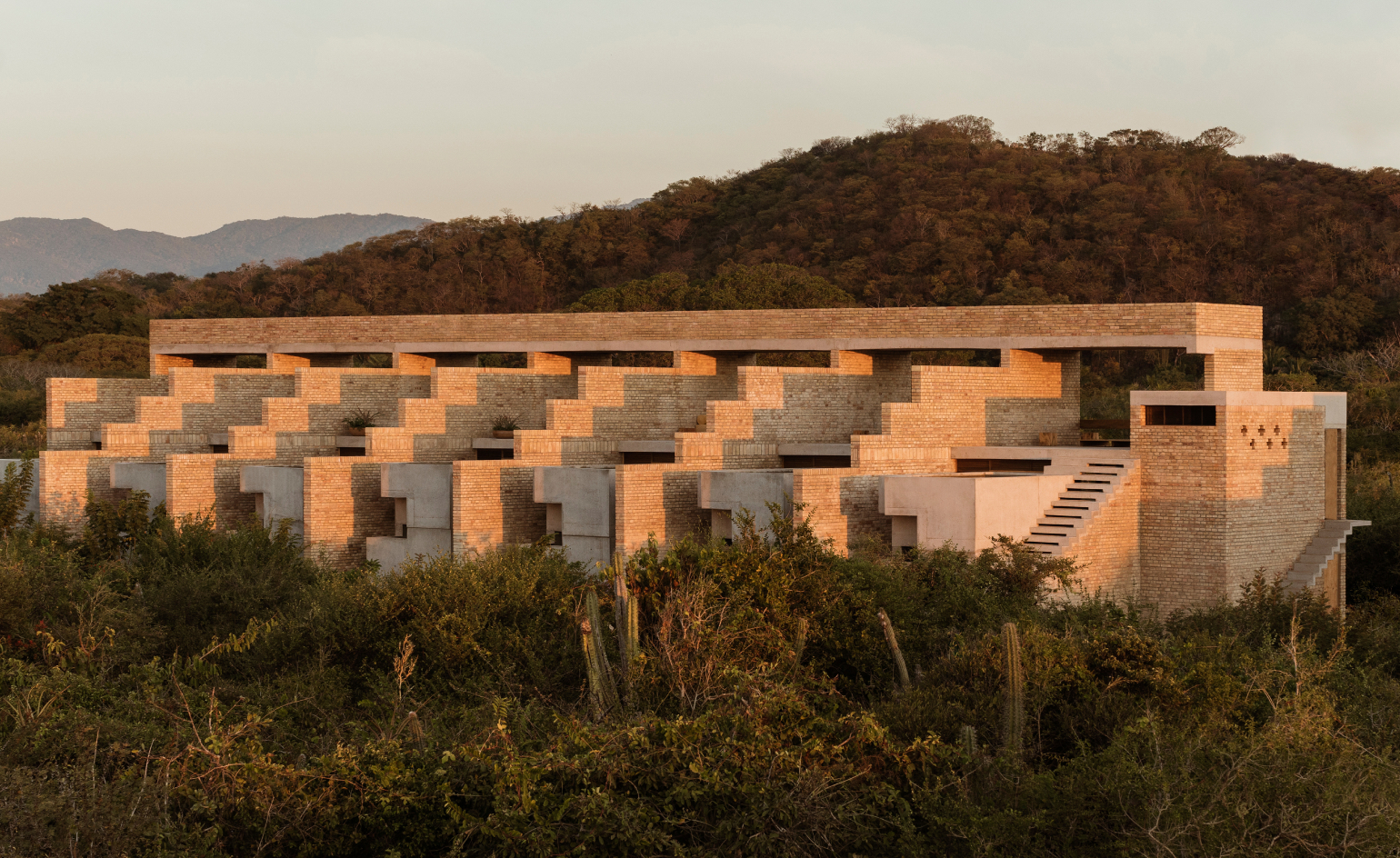
Long renowned in specific circles for its elite surfing, unique ecology, and defiant spirit, Puerto Escondido is hardly as secret as its Spanish name might suggest (escondido means ‘hidden’), attracting visitors from all over the world. Yet, despite its growing popularity, this beloved slice of Oaxacan coastline has never been just any tour-package paradise. Sandwiched between the Pacific and the Sierra Madre del Sur mountains, the town is officially much more than the historic centre most travellers see, from the bioluminescent Laguna de Manialtepec to the lively Zicatela Beach and beyond.
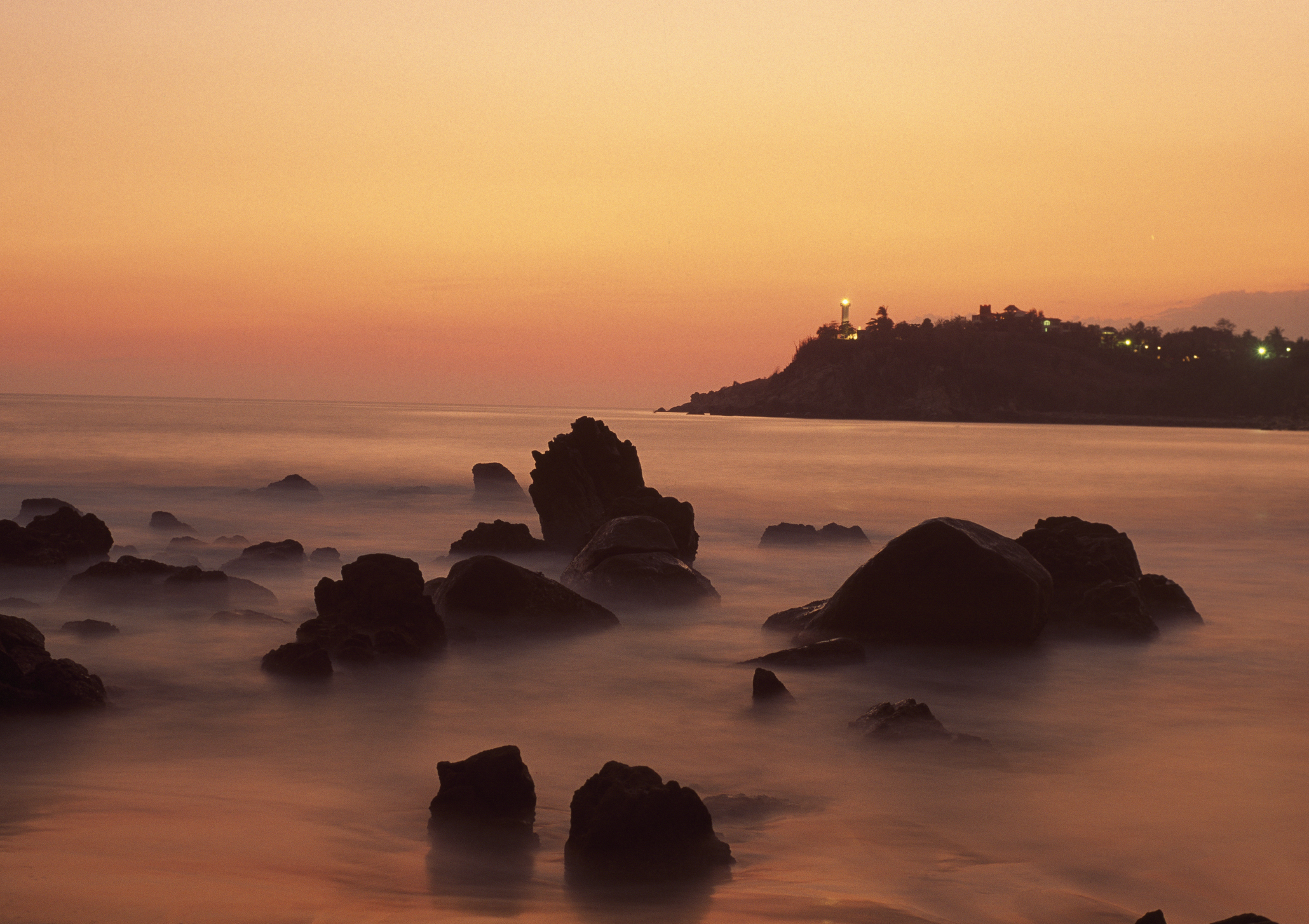
Sunset in Puerto Escondido
In recent years, it’s two local spots, approximately an hour’s drive apart, that are gaining the lion’s share of attention: Punta Pájaros, a private, regenerative development enticing architects around the world (Belgian design collective Archimundo recently hosted part of its educational biennale there), and Punta Zicatela, the surf-friendly enclave that has re-emerged as an option for design-minded travellers inspired by the ethical but in need of something a touch plusher.
Puerto Escondido’s undeniable appeal also comes with a certain edge; it's in one of Mexico’s most impoverished states, where education and infrastructure are severely lacking beyond the capital. Besides, the coast’s world-class waves can make casual swimming perilous across many of its beaches, and with its year-round sun comes extreme heat and the looming threat of drought.
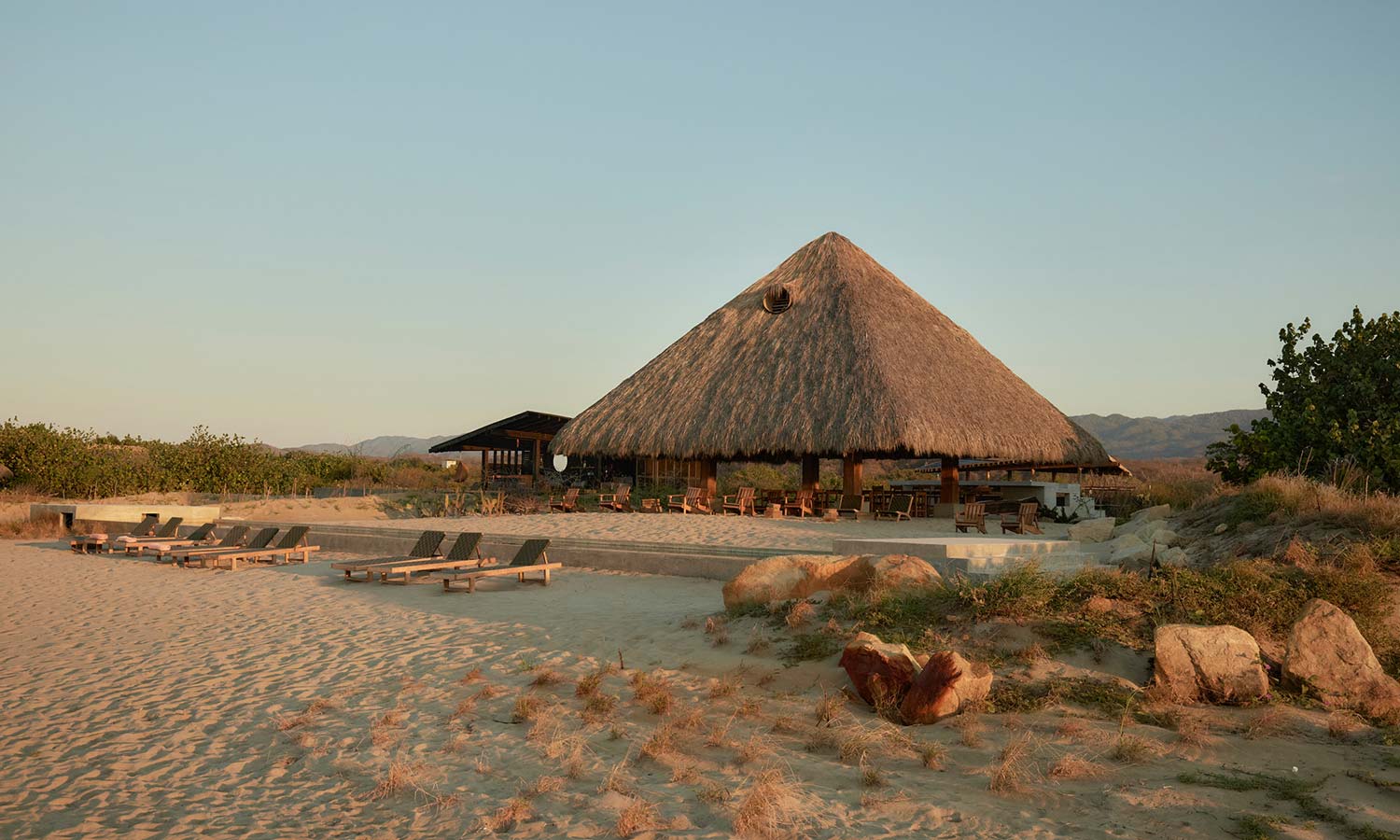
Punta Pájaros
Given the delicate state of an ecosystem prone to flooding and earthquakes (the area was also devastated in 1997 by Hurricane Pauline), a host of stringent regulations – from height restrictions on hotels and residences to nightly curfews on local clubs and bars – have been imposed to protect an increasingly popular Puerto Escondido and the surrounding area from overdevelopment.
Nevertheless, access to Puerto Escondido has increased exponentially, and interest in the area has never been greater. Perhaps by happy consequence, a singular, ostensibly sustainable architectural style has emerged of late in the region, accommodating ecological demands while helping establish this laid-back coast as a rather unlikely centre of design innovation.
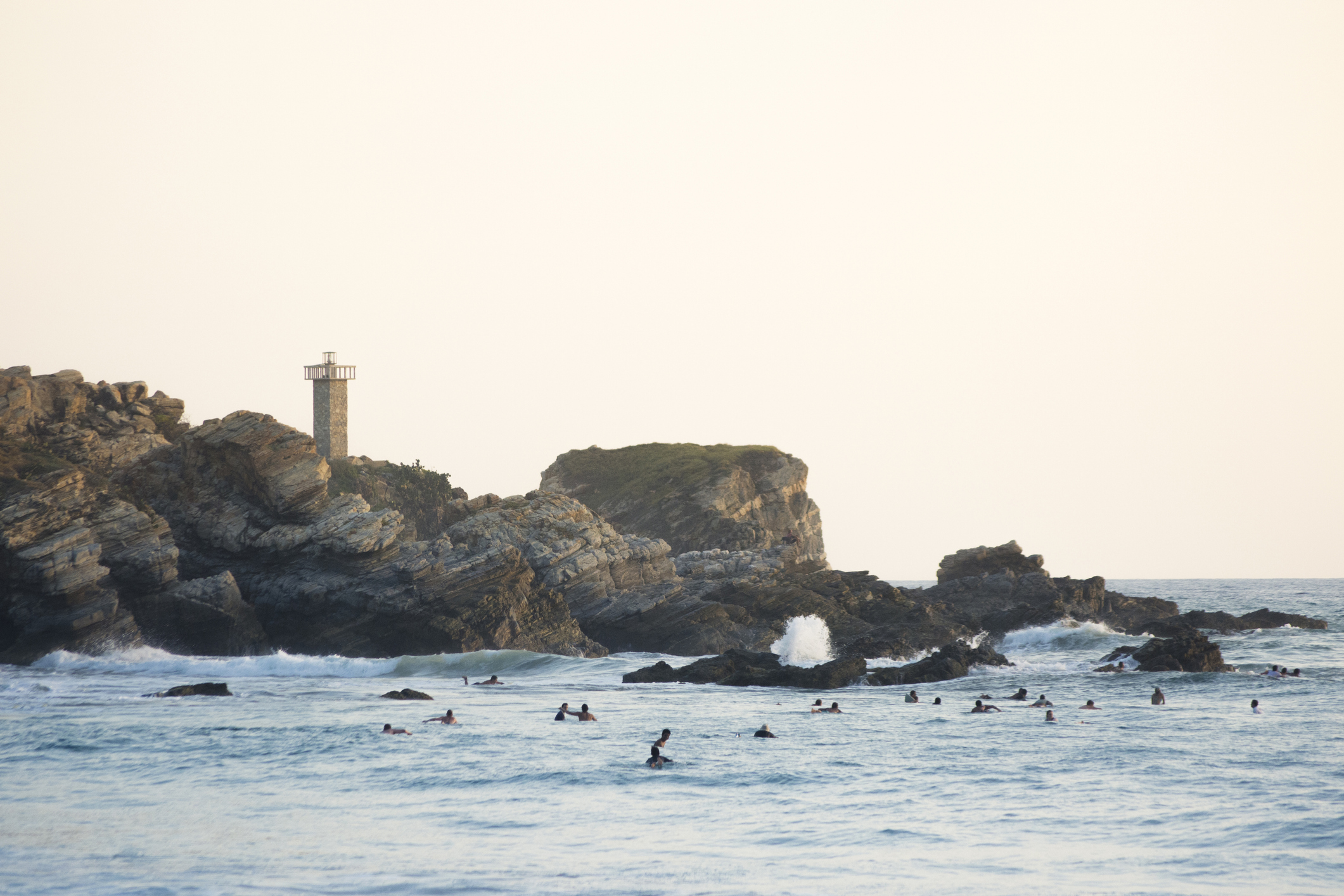
Surfers in Punta Zicatela
Combining traditional construction techniques and local, renewable materials, these site-specific structures aspire to assimilate with the surrounding nature while minimising tourism’s potentially destructive impact upon it. It’s an approach that may not meet everyone’s definition of luxury, but as this location continues to grow in popularity, its architects hope that it can help, rather than hurt, Puerto Escondido’s future.
A planned community

The Manialtepec lagoon in Oaxaca was dyed pink in October 2019
Understanding the current vernacular of hospitality design here requires a look at the foundational projects and architectural milestones that have shaped its recent evolution. For decades, Puerto Escondido would be described as some kind of gem waiting to be unearthed. In the 1970s, the government’s national tourism fund designated the site, alongside Cancún and Zihuatanejo, to be developed as Mexico’s next tourist hotspot, but the plan unravelled in 1980, reportedly because the American who owned a large swathe of Puerto Escondido’s land refused to sell.
Receive our daily digest of inspiration, escapism and design stories from around the world direct to your inbox.
As new hotels sprouted up along Zicatela Beach in the 1980s, Mexico City-based developer and environmentalist Rodolfo Ogarrio managed to evade government oversight to found Punta Zicatela Ecological Community, a gated community just a few metres east, ostensibly to protect the area’s last indigenous forest. With this came several noteworthy homes by the Jaliscan architect Diego Villaseñor.
Casa Roca Rojas (1991) stands as one of the earliest examples of the current architectural style: the home is built into the rock and immersed in the greenery, its face cut open in smooth, sweeping arches fully exposed to the sea. Villaseñor mixed pre-colonial elements – palapa (a thatched roof made of dried palm leaves) and rough stone walls – with fluid, modern forms that would leverage sunlight and Pacific breezes. Whether the work was ahead of its time or mired in the ways of the past, its influence would certainly be felt along the coast in the coming years.
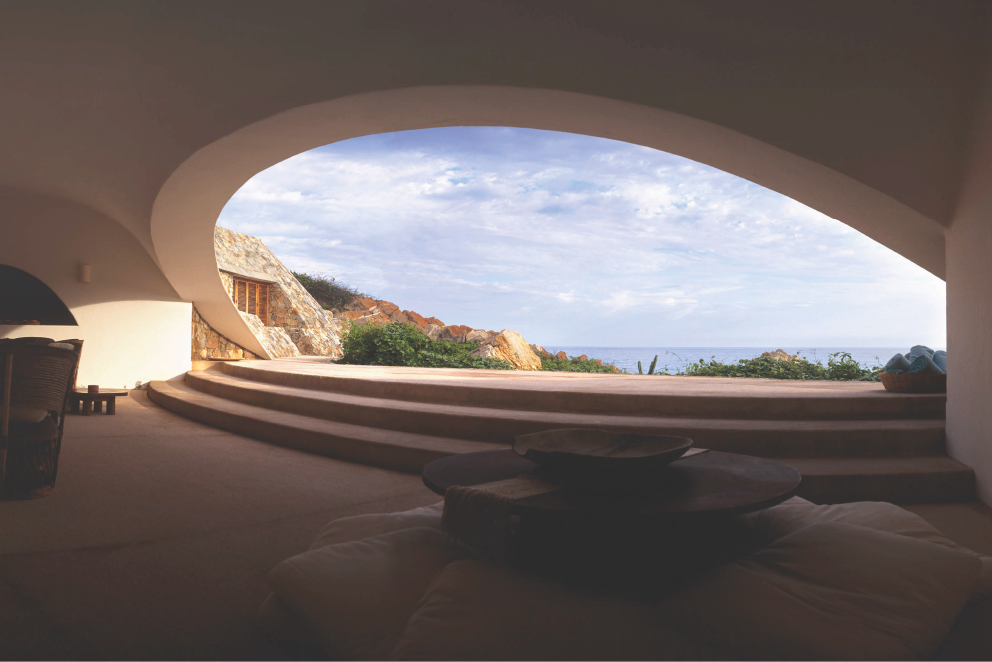
Casa Roca Rojas
In 2014, Mexico City-born artist Bosco Sodi and collaborators established a hub for low-impact, eco-conscious design with Fundación Casa Wabi, originating a new architectural chapter for the region. Seeking to create a non-profit art centre and residency that worked with the ecosystem rather than against it, following years of irresponsible agricultural practices, Sodi enlisted Pritzker Prize-winning architect Tadao Ando.
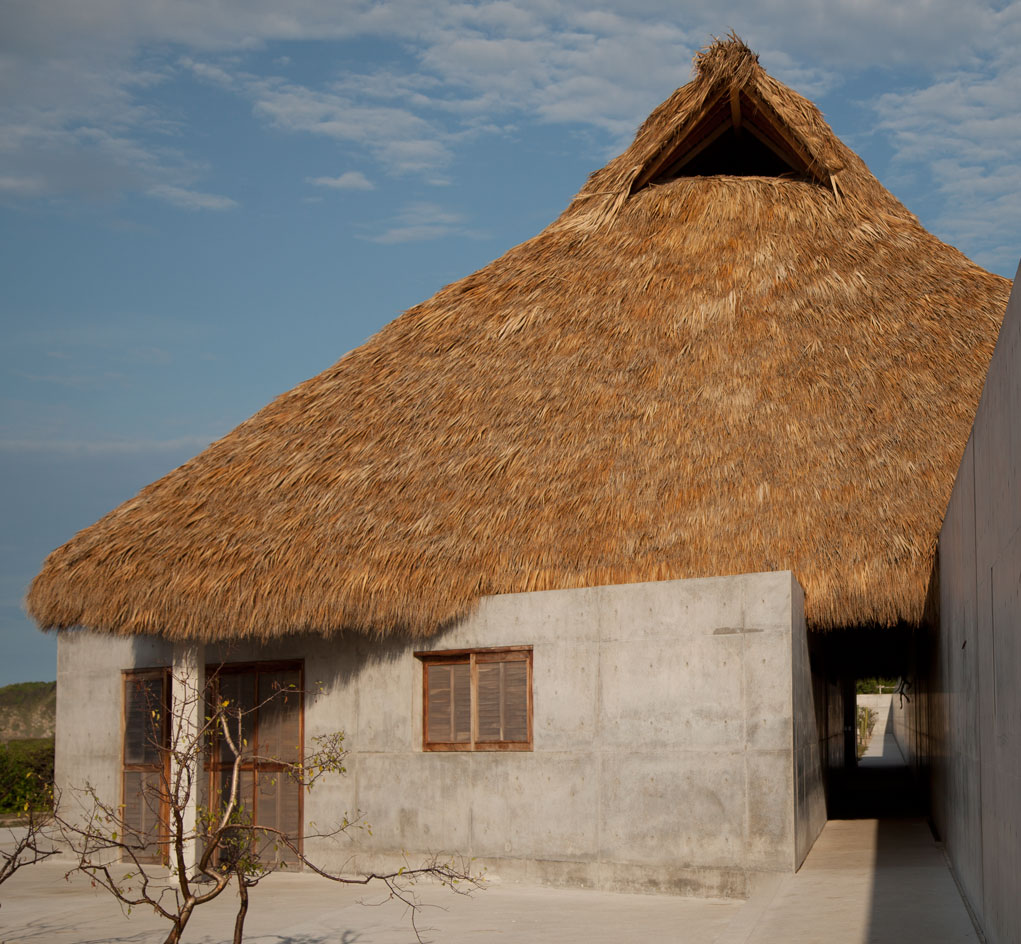
The architecture of Casa Wabi combines modern and traditional materials and techniques
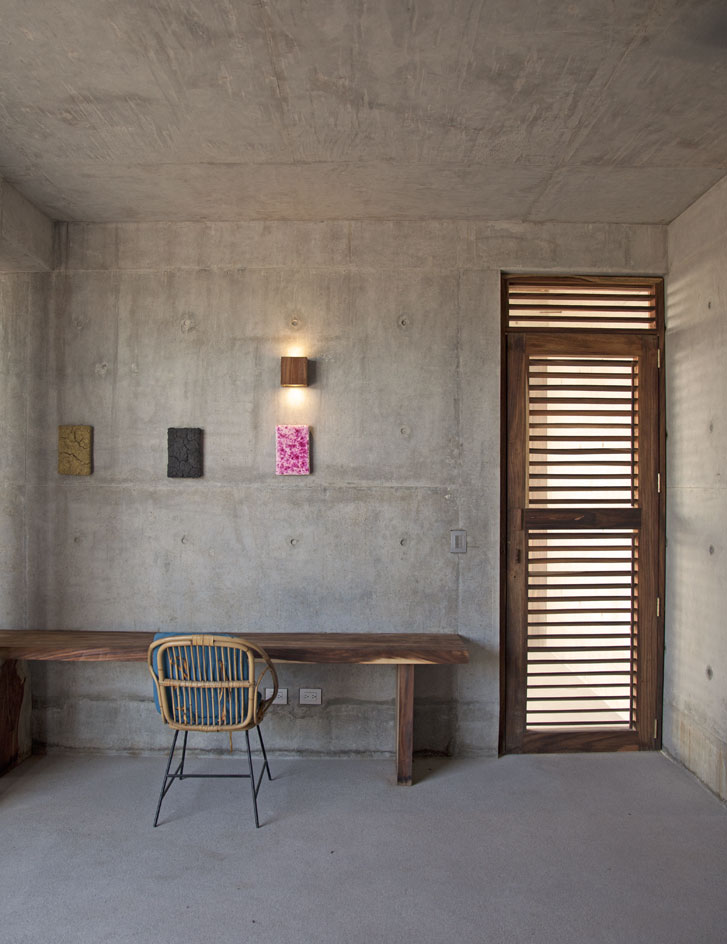
The complex includes two studios, an exhibition space and several multipurpose spaces
Casa Wabi’s main structure echoes Ando’s Japanese work – starkly geometric concrete hugs the landscape, yet also bears traditional influence, dominated by a mammoth, hand-woven palapa roof. Open to the elements, the building plays with light and breeze: shifting shadows in its cylindrical observatory evoke those at Casa Roca Rojas, while sea air accelerates clay-drying in its open-air workshop, minimising the need for air conditioning along the arid coast.
A new wave of hospitality design
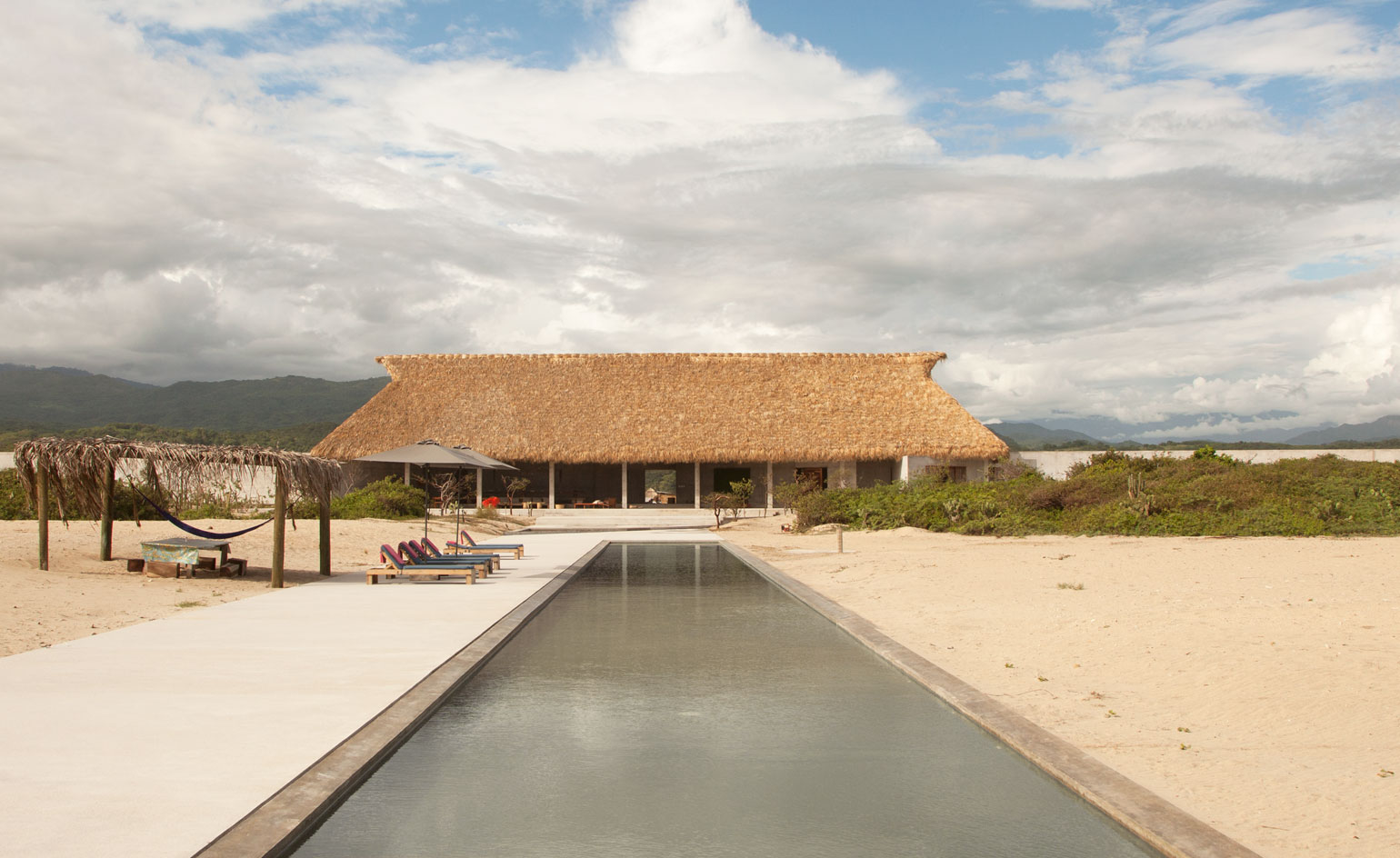
At Casa Wabi, the structures are concrete, following Ando’s signature style, but the architect also uses the region’s traditional ‘palapa’ pavilions
Just months before Ando and his team completed work on Casa Wabi in 2014, Mexico City-based hotelier Grupo Habita was completing the first of many design-led lodgings to be built on Sodi’s land. Credited among Mexico’s pioneers in high-design boutique hotels, the group opened its first property, Hotel Habita in Mexico City, back in 2000. Like Ando, Grupo Habita stresses a governing ethos of hyper-locality to keep its hotels rooted in place, wherever they are. ‘We use a local team every time we build a hotel,’ notes co-founder Carlos Couturier, ‘and we read the surroundings and their traditions to integrate the local culture into our project.’
In Punta Pájaros, architect Federico Rivera Río conceived Grupo Habita’s Hotel Escondido to marry that mentality with an approach combining ‘ancestral forms and customs with geometric rigour’. Though the hotel takes a more aesthetically conservative, casual approach to Casa Wabi’s vernacular brutalism, it shares the art centre’s embrace of nature, featuring 16 beachside, open-air bungalows equipped with private plunge pools strewn among the native vegetation.
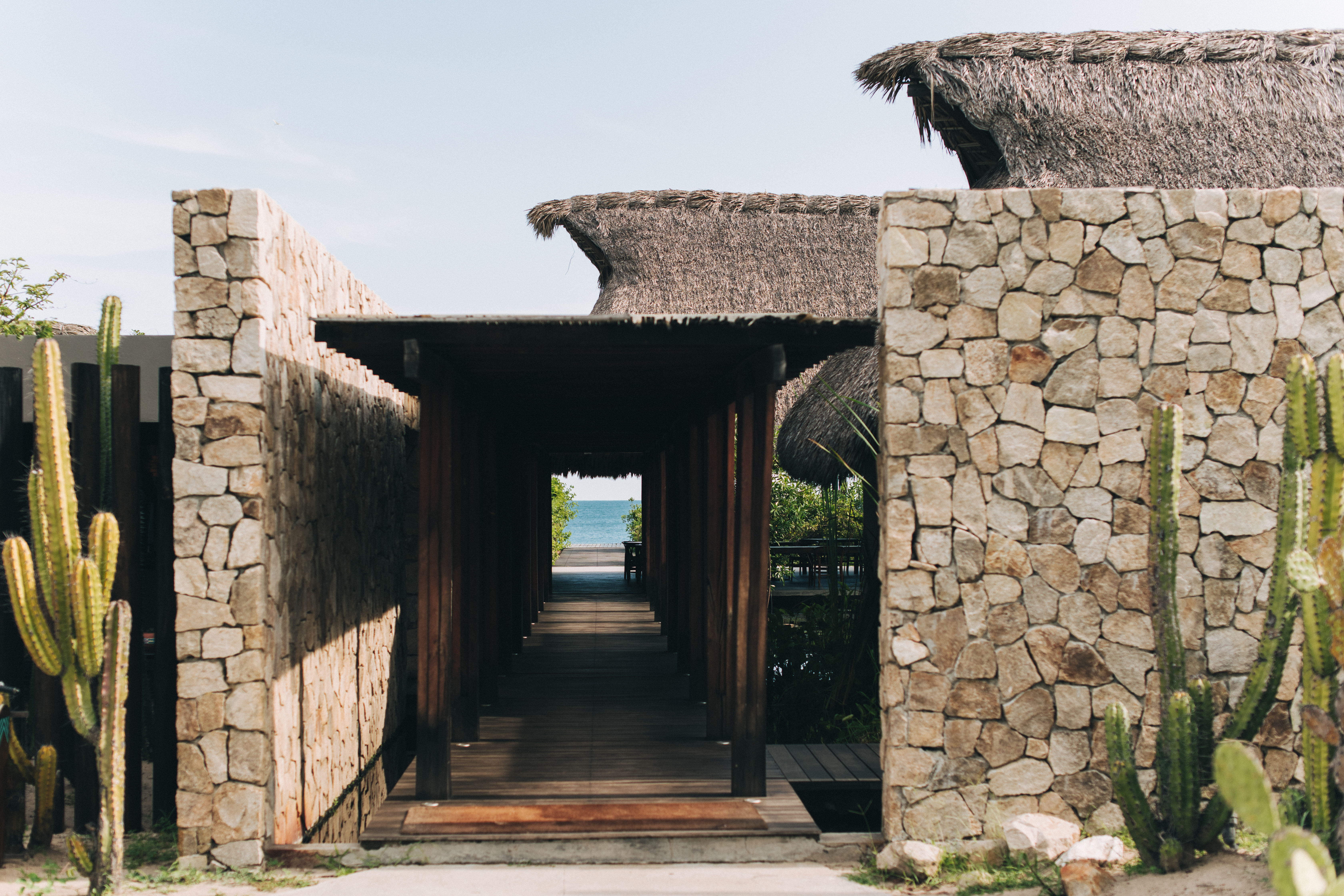
Hotel Escondido
To help keep things cool in its public spaces, a living pond runs along the stone wall of the entryway, giving way to a public pool topped by hueso de palma awnings, traditionally used for shade in the neighbouring region of Costa Chica. The rooms, simply detailed in poured concrete and local, fast-growing woods like huanacaxtle and macuil, are modern but restrained, and with their screened-in walls and palapa roof, being soothed to sleep with the sound of crashing waves and fresh ocean breezes feels like an extraordinary indulgence.
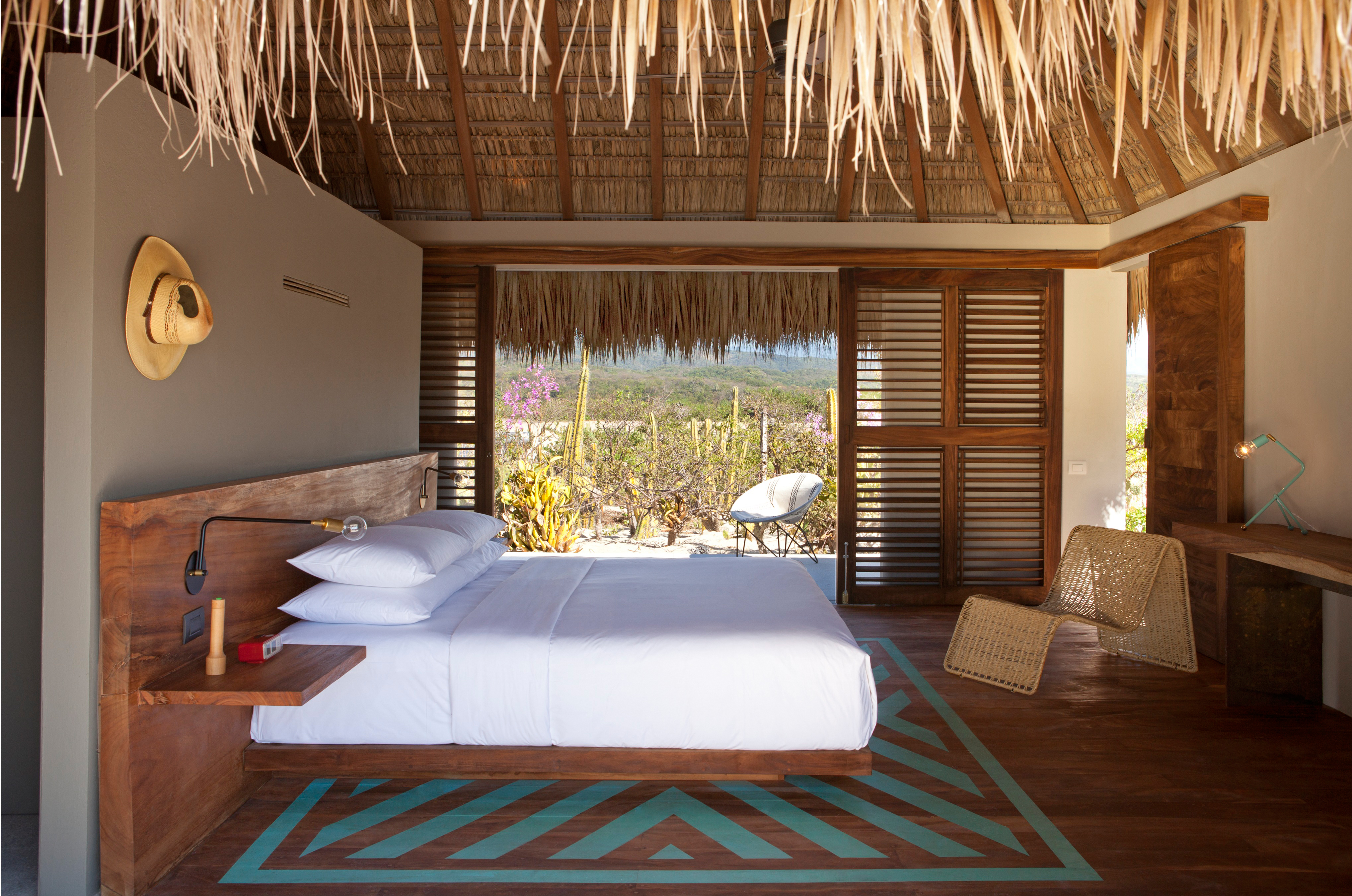
Hotel Escondido

Hotel Escondido
Under the watch of an ‘informal council’ consisting of Sodi, Mexican architect Alberto Kalach and Grupo Habita’s other co-founder, Moisés Micha, and in the wake of Hotel Escondido’s completion, in 2014, dozens of smaller structures and vacation rentals have sprouted up in the immediate surroundings. Among them, Ambrosi Etchegaray’s breezy, vaulted Casa Volta utilises brick recycled from Casa Wabi’s workshops and hueso de palma screens to insulate the space from the heavy sun.
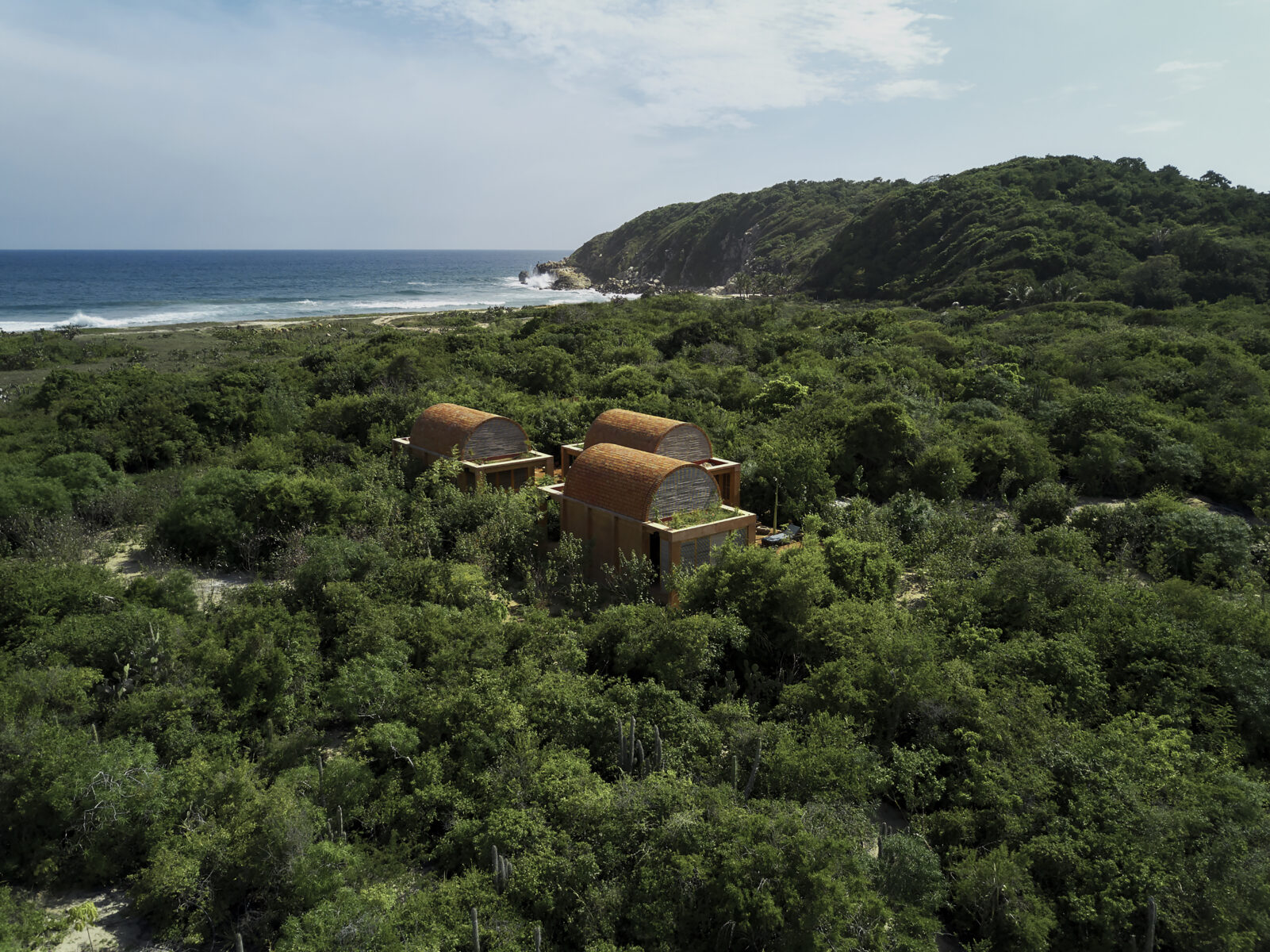
Casa Volta
Meanwhile, S-AR’s Casa Cosmos is a modular, anti-seismic grid of concrete colonnades and sliding, slatted wood panels, again featuring an open-door policy with nature while looking like it was spliced from an Atomic Age nuclear reactor.
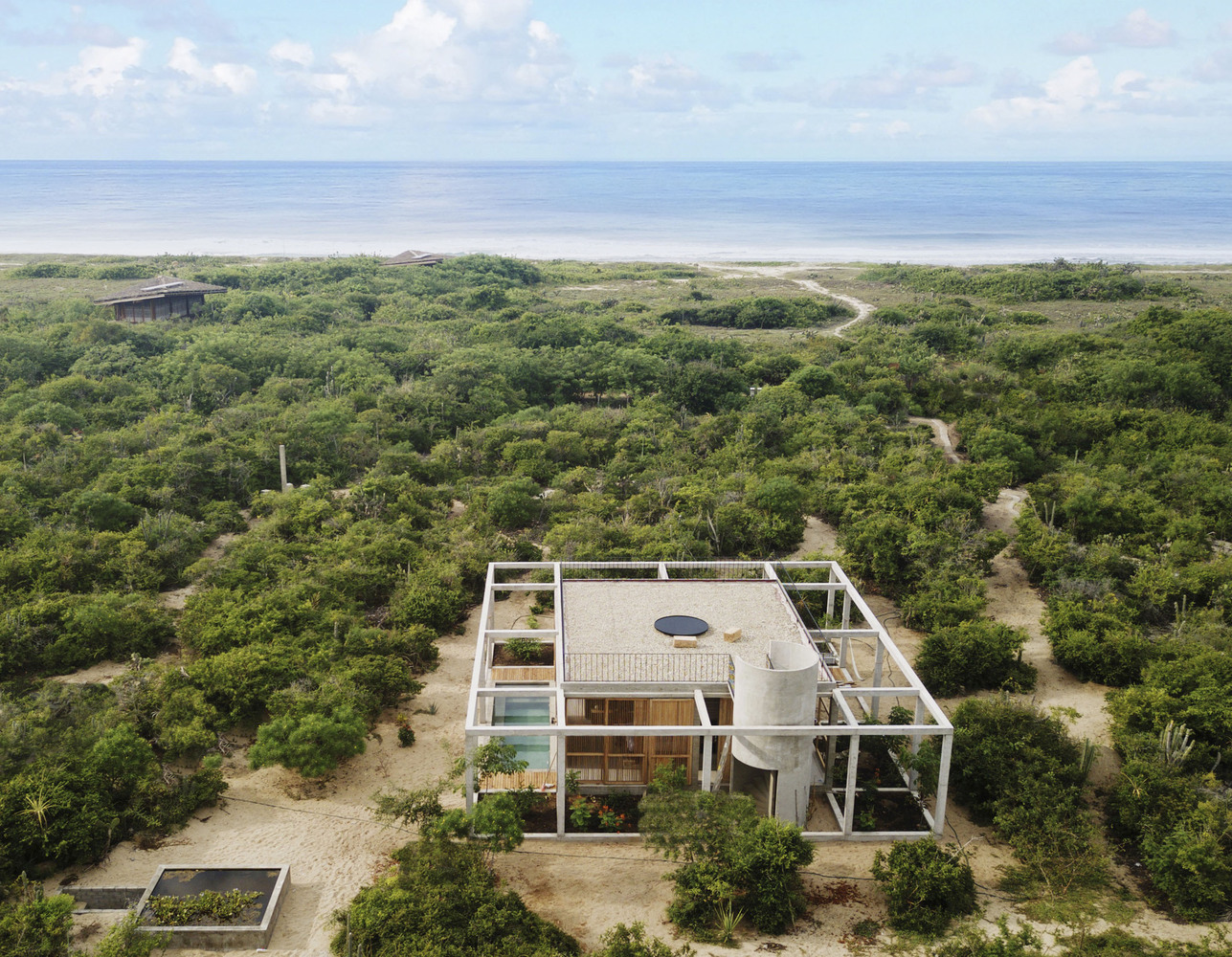
Casa Cosmos
Nearby, Grupo Habita’s flagship restaurant, Kakurega Omakase (which won a Wallpaper* Design Award in 2021), reflects Casa Wabi’s eastern influence in both cuisine and design. A joint project between Kalach’s Taller de Arquitectura X (TAX) and Urrutia, Kakurega’s two levels are hidden – as the name ‘kakurega’ suggests – underneath a massive palapa: the first level, looking like an alcove from an ancient ruin, features a mirror pool and squared staircase set against fired brick; the second, a dining area within a charred, yakisugi-style wood framework, stands exposed in all directions to the whims of the jungle, and lends a soundtrack to one’s meal while conflating past and present, east and west, wild and refined.

Kakurega Omakase
In terms of volume alone, no other architect can quite claim the impact that Kalach has had on this coast, where he continues to refine this low-intervention vision. His practice unveiled Hotel Terrestre in Punta Pájaros in February 2022 – its most ambitious project to date, and which received a Wallpaper* Design Award the same year.
Another Grupo Habita property, Hotel Terrestre boasts 14 villas, uniformly constructed from sand-coloured, locally fired brick, looking as much like some Soviet-era, brutalist experiment as they do the preserved remains of an ancient, Mesoamerican – or even Mesopotamian – temple. Pushing its eco-friendly ethos to the limits of comfort and convenience, Hotel Terrestre is built entirely from materials sourced from within a kilometre of the property and runs entirely on solar power.

Hotel Terrestre
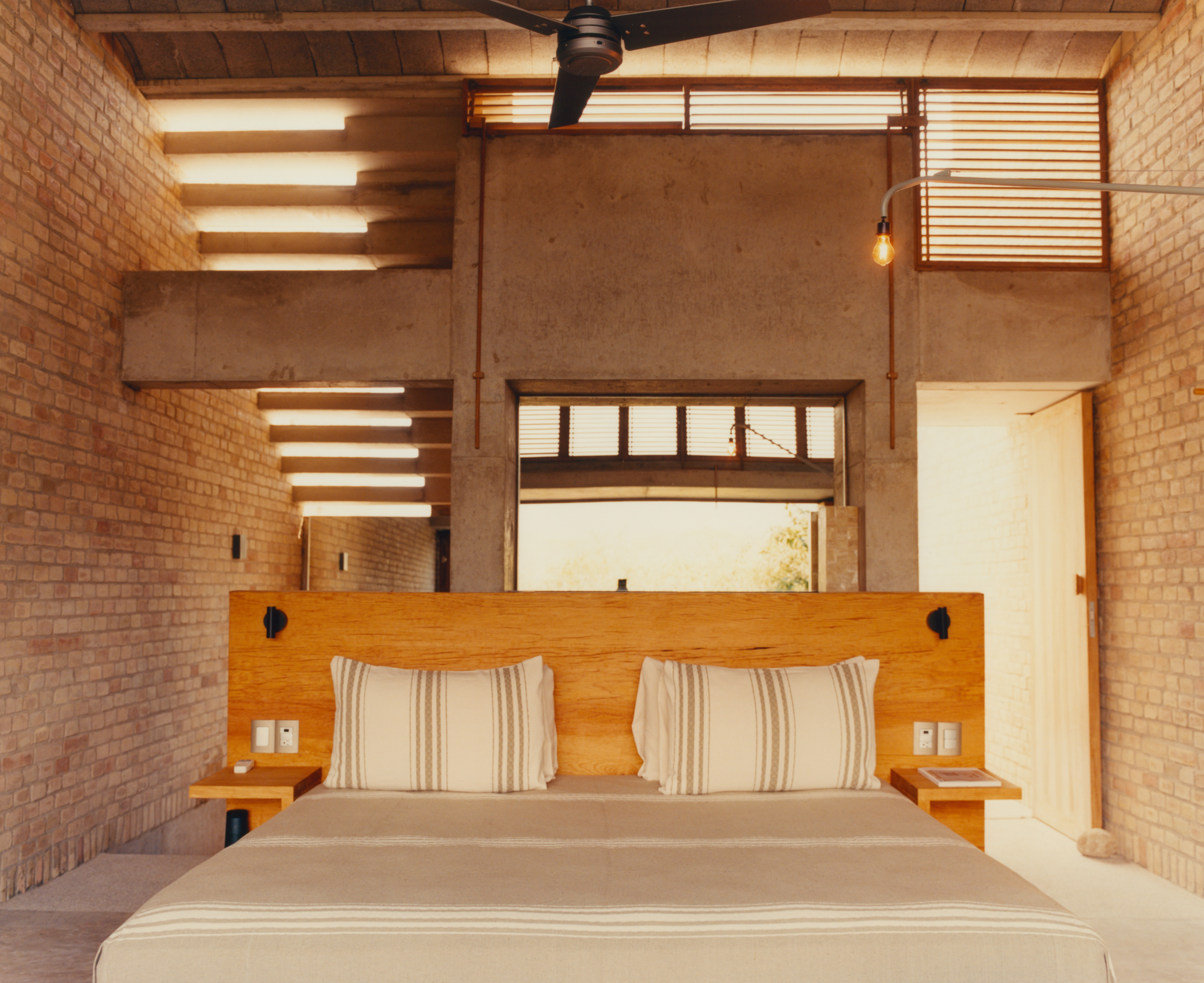
Hotel Terrestre
With amenities including a restaurant, a spa, and a hammam, but with minimal technology and no extraneous lighting, guests are forced to truly convene with nature here, relying on the moon and stars to find their villa in the thicket by night. TAX utilises more simple, time-tested approaches to cool each villa, including rooftop plunge pools to intercept the sun, roofless showers to promote the room’s air circulation, and minimalist, heat-absorbing concrete interiors which, incidentally, lend the space a disorienting futuristic feel.
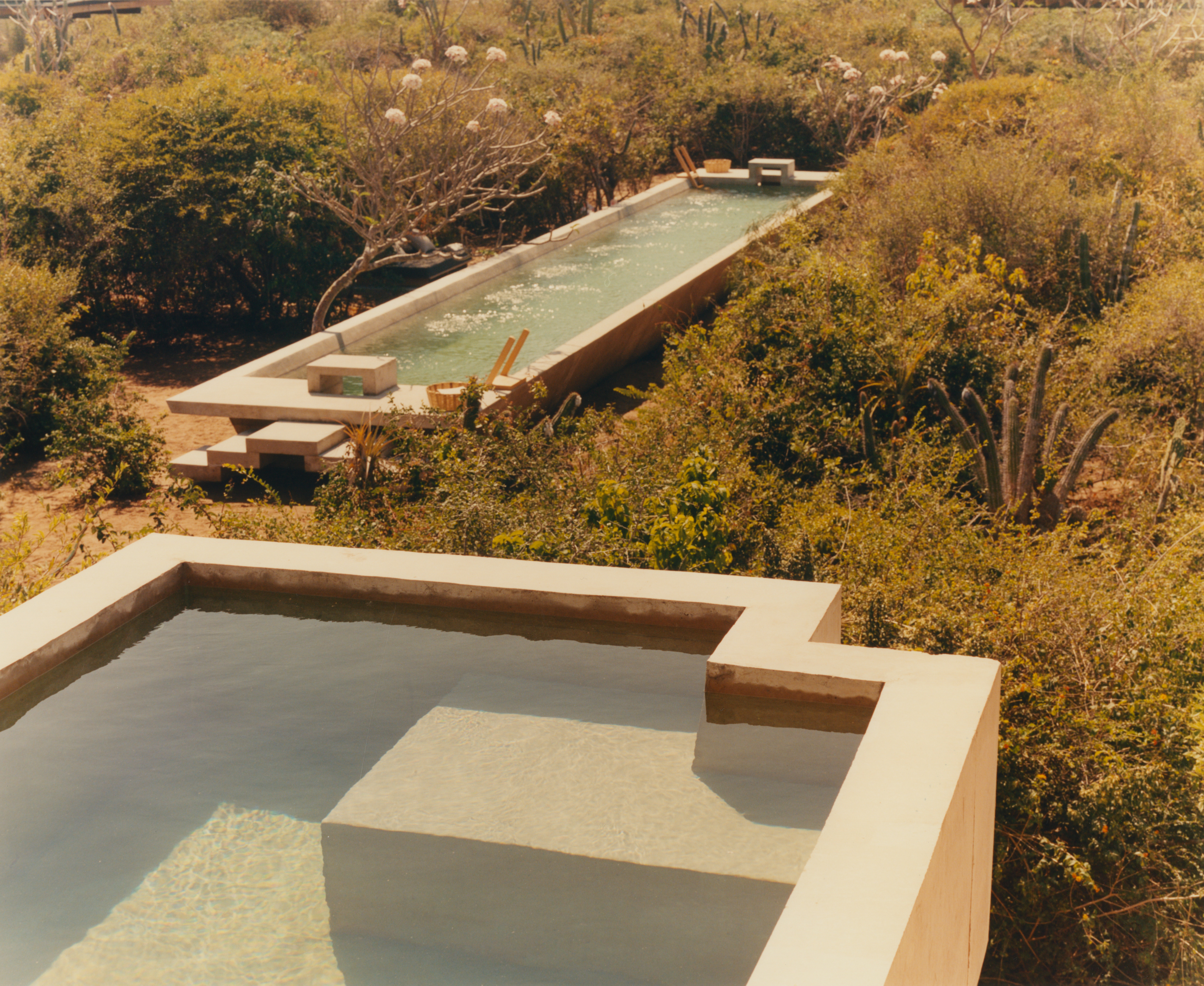
Hotel Terrestre
Back in the urban heart of Punta Zicatela, similarly ‘luxurious’ properties have launched in recent years, working within Puerto Escondido’s ecological restrictions and architectural ethos while applying a traditional approach to design. In 2019, husband-and-wife team Surreal Estate tasked French architect Ludwig Godefroy (whose fortress-like Casa Alferez and theatrical Casa La Paz Wallpaper* has previously explored) with building two homes within a limited 150 sq m footprint, which they hoped would ‘blend into the local landscape over time while also blowing the mind of anyone who might look at them’.
The result, Casa VO (2020), is an exposed, cavernous, windowless expression of tropical brutalism. It would quickly be paired with the now-adjoining Casa WO (2021), then topped in scale by Godefroy’s signature work, the almost interdimensional Casa TO (2022).
Nearby, Xiqué Hotel Boutique adapts to local demands with a novel and visually arresting approach. Recalling the streamlined modern architecture of the 1930s, the Estudio Carroll-designed structure stands out with its curvaceous pink façade, porthole windows, and slatted palm wood panels.
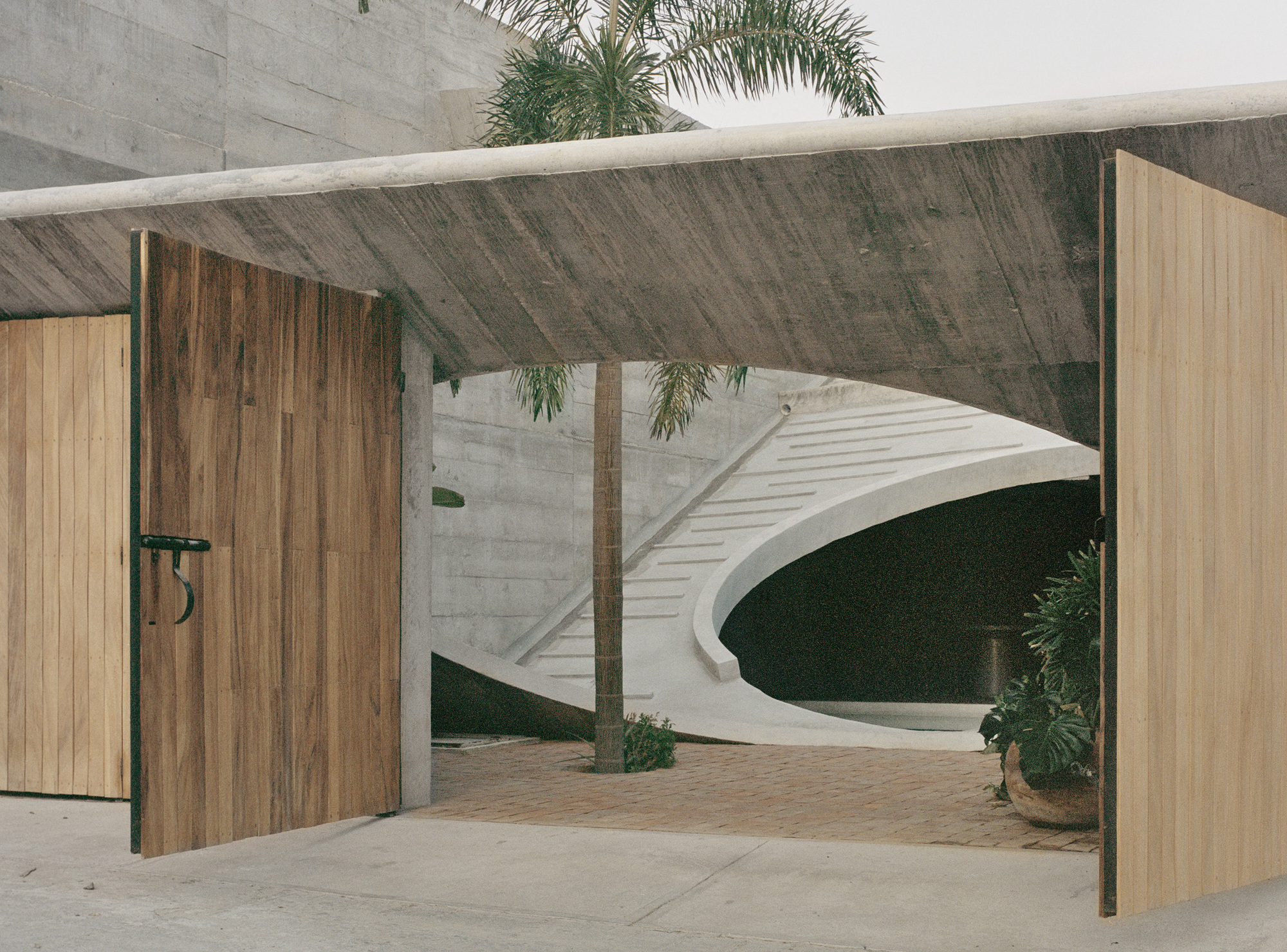
Casa VO
Surfaced in pigmented chukum, a waterproof, heat-absorbing kind of stucco traditionally made from the bark of a tree indigenous to the Yucatan, the hotel was built around – and named for – the old-growth almendro trees in its central courtyard. Growing freely, such foliage not only reduces surface temperatures, but also helps purify the hotel’s wastewater through a biofiltration system modelled after those naturally occurring in wetlands and marshes. Moreover, though the architects have since supplied the rooms with HVAC, the studio claims Xiqué’s curves are deliberately oriented to promote the circulation of hot air, which is then ventilated like a ‘natural chimney’ up and out of the building through its open-air staircase.
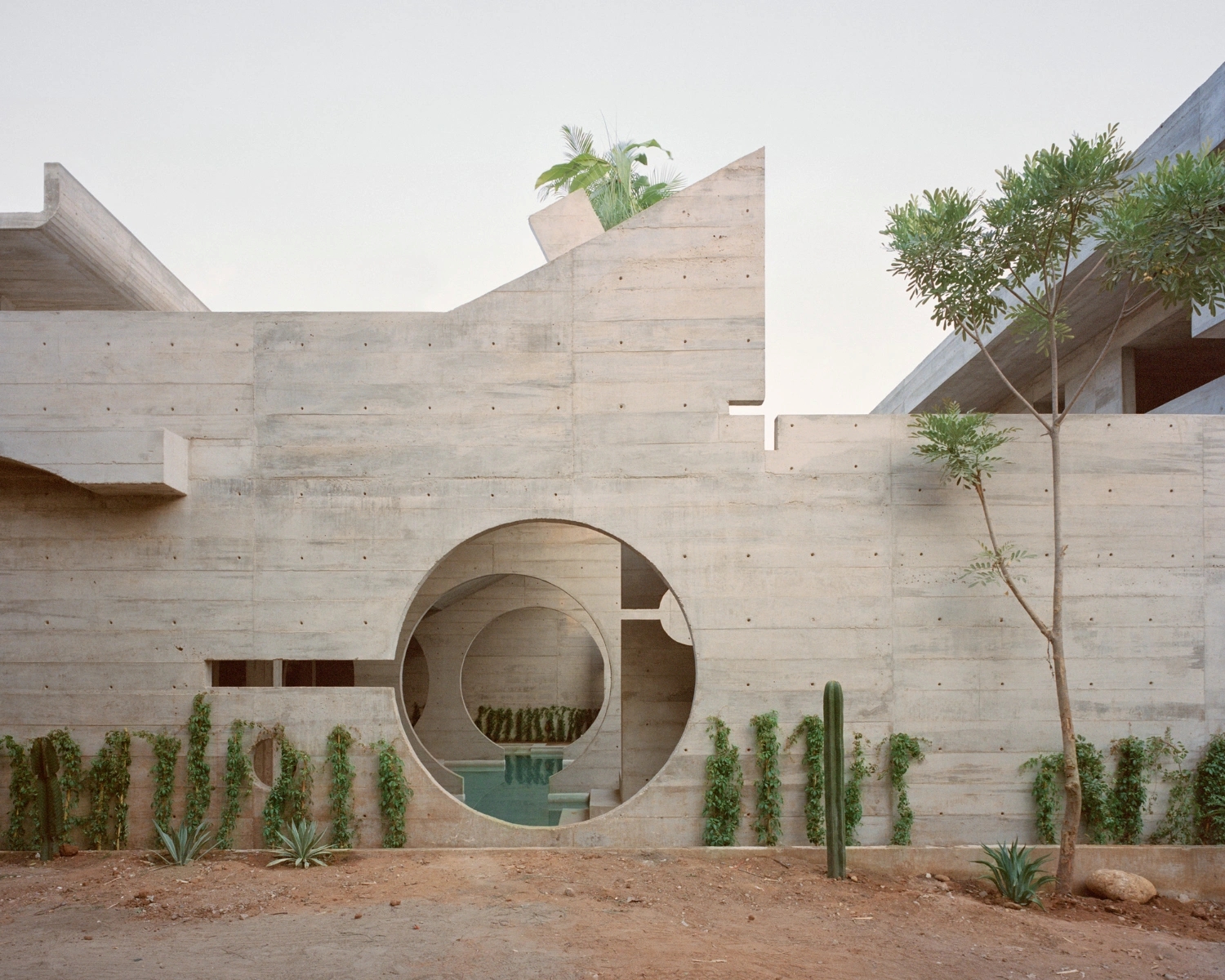
Casa TO

Casa TO
On the main drag of Punta de Zicatela, where barefoot surfers commingle with the high-style jetset at luxe-bohemian bars and boutiques, Grupo Habita’s newest property, Hotel Humano, might represent a new, increasingly urbane chapter of Puerto Escondido’s ever-evolving story.
Inaugurated in December 2024, the Jorge Hernandez de la Garza-constructed property does pays homage to the city’s more brutalist traditions, most overtly in the raw, perforated brick so heavily featured in much of TAX’s work, not to mention the strikingly brutalist Puerto Escondido Cathedral found in Centro, but does so in a markedly more metropolitan, restrained way. Encompassing several storefronts along Calle Alejandro Cárdenas Peralta, Humano’s latticed exterior dapples the hotel’s interior in patterns that recur in glazed-tile walls and the concrete grid framing the internal terraces of the 39 guest rooms.

Hotel Humano
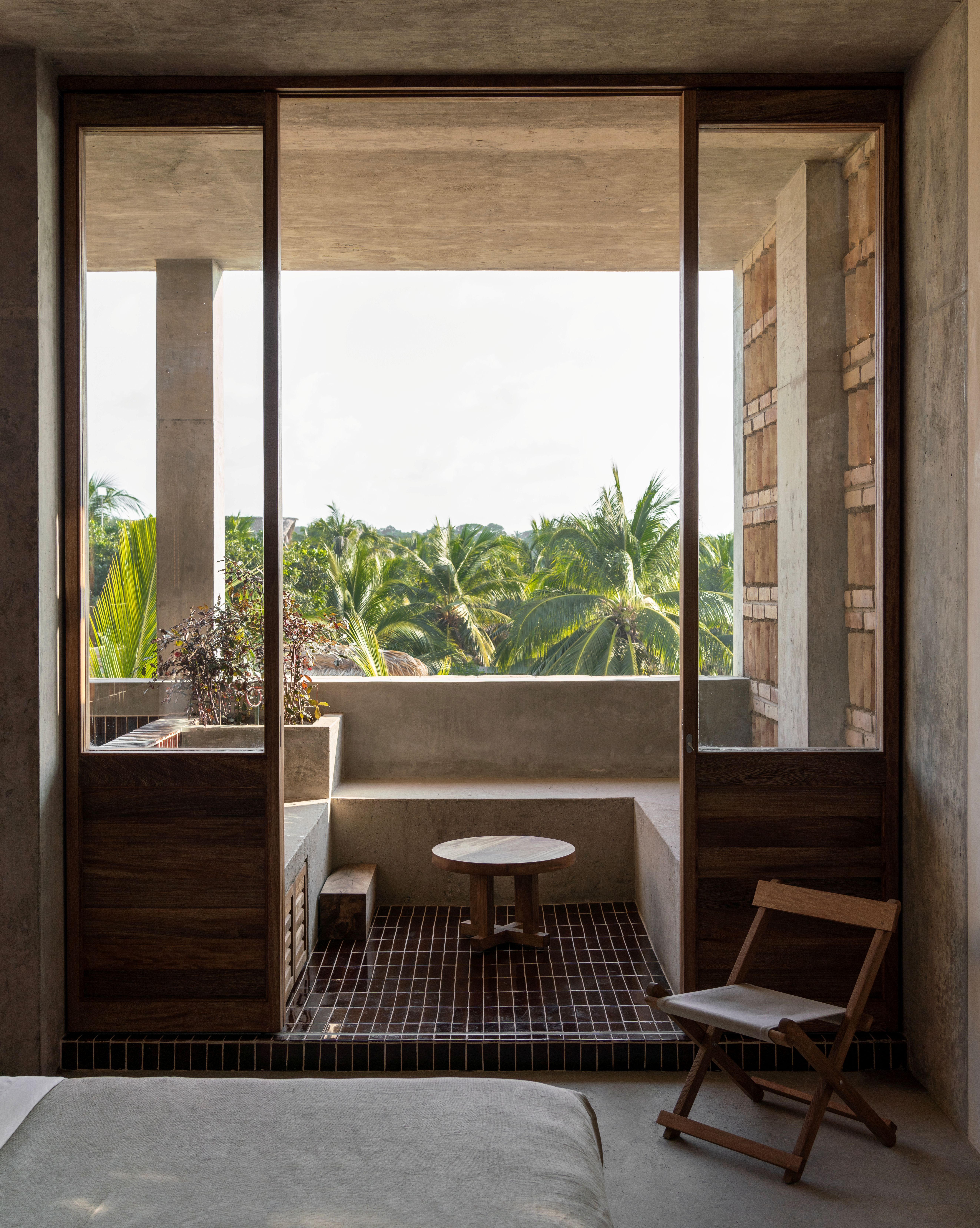
Hotel Humano
Though the hotel’s ventilated façade ensures that Hotel Humano isn’t entirely sealed off from its surroundings, it is fully climate-controlled and refined in its design, making a clear break from the radical, off-the-grid approach manifest in Hotel Terrestre. Designed by Plantea Estudio, a Spanish firm that typically works in retail spaces and restaurants in their home country, the rooms are unquestionably modern, sporting industrial stainless steel sinks and polished concrete floors, while the central courtyard is marked by swaying palm trees and a palapa that hovers over a rather elegant poolside bar and restaurant well-suited for lounging in style.
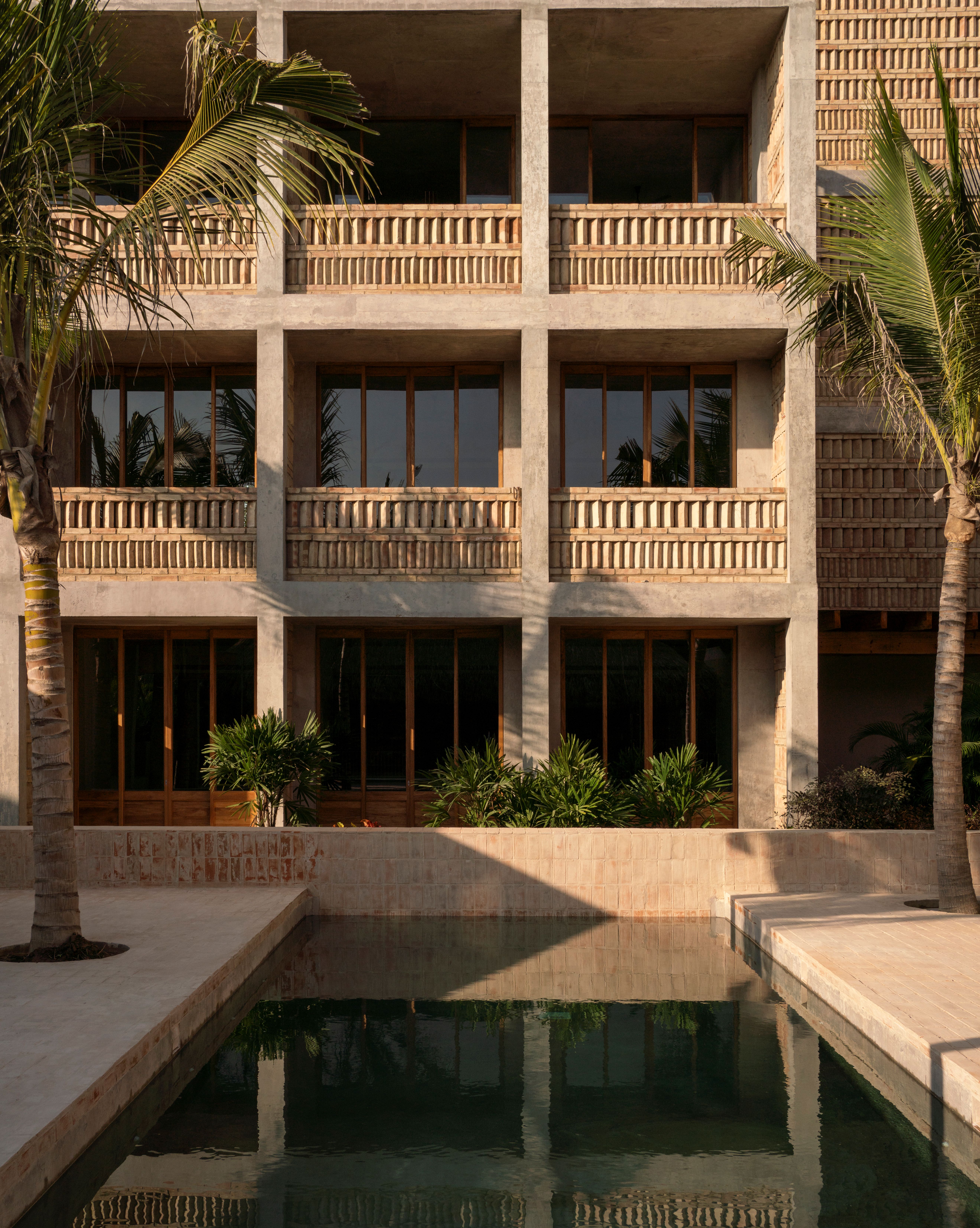
Hotel Humano
As Puerto Escondido becomes more accessible than it’s ever been. The recent completion of the new and controversial Barranca Larga-Ventanilla Highway has slashed the drive from Oaxaca City from eight hours to three; the once-tiny Puerto Escondido airport has recently begun welcoming its first direct international flights from Houston, Texas. With over two billion Mexican dollars (approximately £77,000,000) allocated toward its expansion, many more flights – and travellers – are on their way.
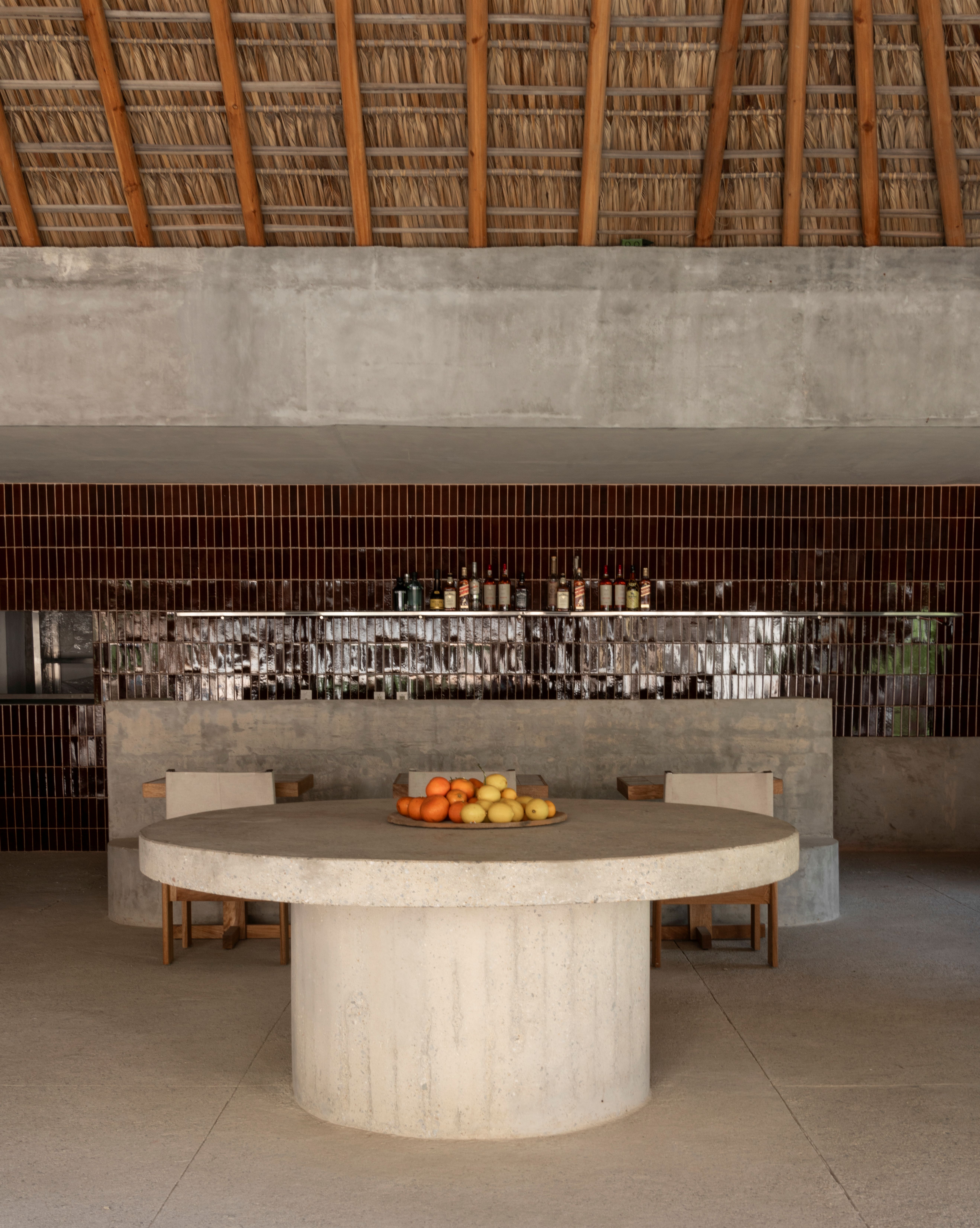
Hotel Humano
Enterprising hoteliers are responding in kind, as construction sites seemingly sprout up at every turn. Set to expand Hotel Humano with a spa and a neighbouring beach club, due to open within the year, Grupo Habita is clearly betting on the future of Punta Zicatela, and by the look of it, the group is far from alone, with new construction sites popping up seemingly on every open corner, including a forthcoming residence from Kalach and TAX.
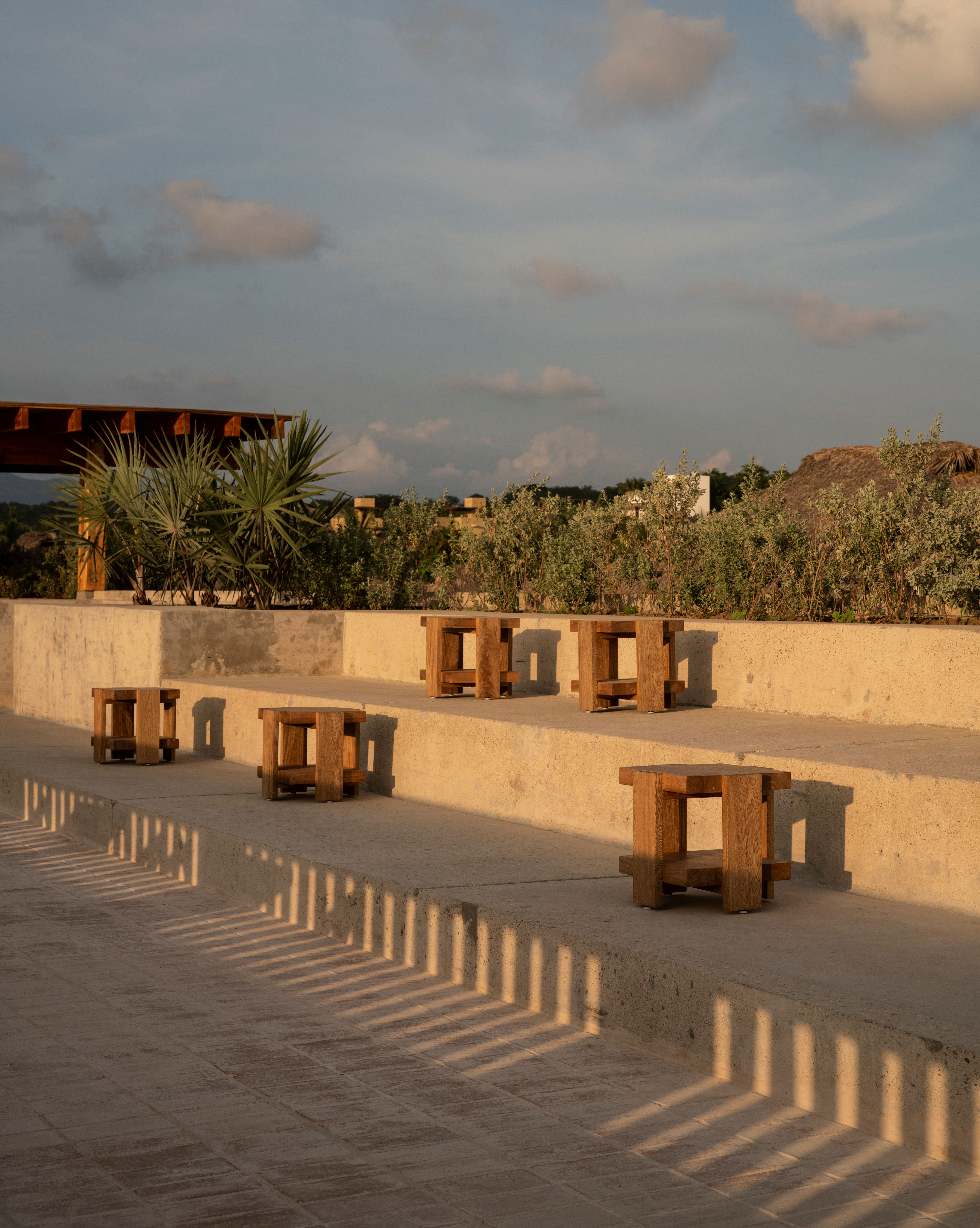
That’s not to say that Puerto Escondido is destined to become the next Cancún, either: as if to warn ambitious developers, a monstrous, seven-storey would-be hotel stands abandoned along Zicatela Beach. After well over a decade of grassroots campaigning from groups such as Costa Unida, Salvemos Colorada, and SOS Puerto, plans to transform 111 wild acres into a massive tourism complex and commercial marina on the western flank of the airport have been quashed – for now.
Still, given that this long ‘hidden gem’ has been unearthed, fully and finally, one can hardly fault those who worry about what comes next for Puerto Escondido’s future, posing the question: can its eclectic, ecologically integrative approach to construction provide a truly sustainable pathway forward?
In need of more travel inspiration? Check out our trip to Mexico’s San Miguel de Allende
Eric Millman is a freelance writer based in Oakland, California. Specializing in food and travel, his work has been featured in a variety of outlets, including AFAR, Italy Magazine, Gastro Obscura, and Whetstone. He is the co-founder of a vaguely Italianate travel blog called Perdigiornale.
-
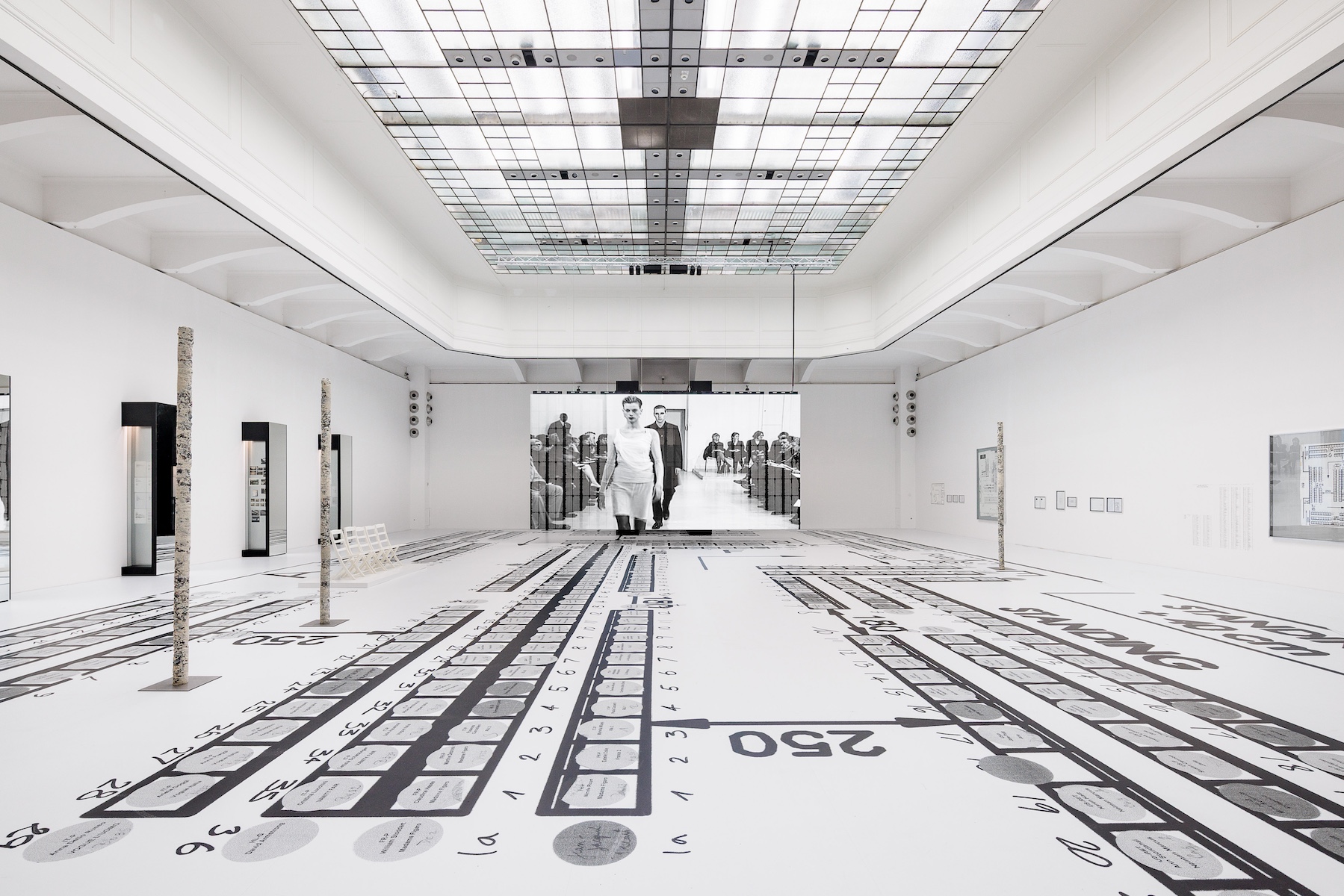 Inside Helmut Lang’s fashion archive in Vienna, which still defines how we dress today
Inside Helmut Lang’s fashion archive in Vienna, which still defines how we dress todayNew exhibition ‘Séance de Travail 1986-2005’ at MAK in Vienna puts Helmut Lang’s extraordinary fashion archive on view for the first time, capturing the Austrian designer-turned-artist’s enduring legacy
-
 Eclectic and colourful, Charlie Ferrer’s home reflects the interior designer’s personal and professional evolution
Eclectic and colourful, Charlie Ferrer’s home reflects the interior designer’s personal and professional evolutionThe New York interior designer invites us into his new Greenwich Village home: come on in
-
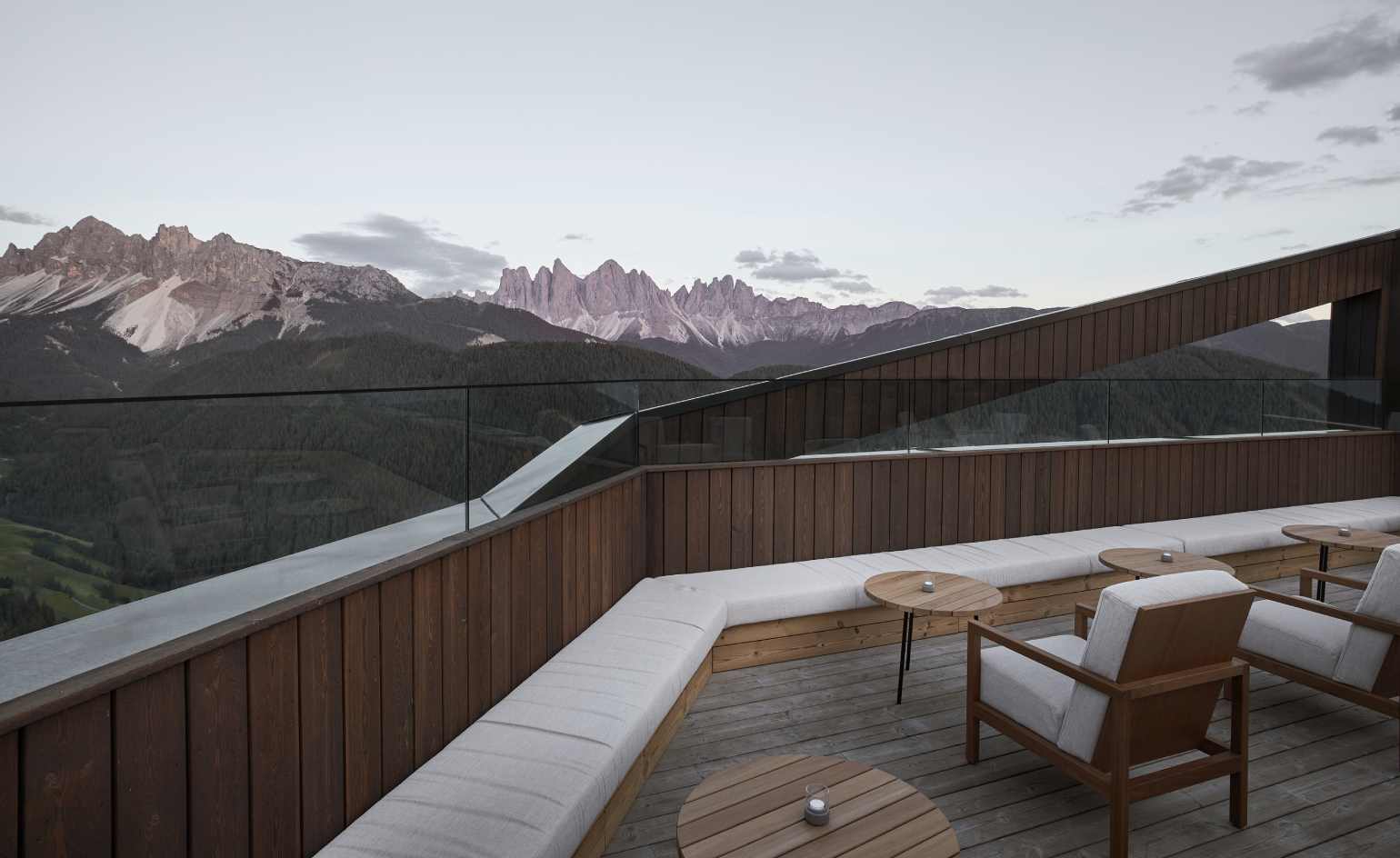 Heading to the 2026 Winter Olympic Games? Don’t miss these stops along the way
Heading to the 2026 Winter Olympic Games? Don’t miss these stops along the wayAs the anticipated winter games draw near, Wallpaper*’s Milan editor, Laura May Todd, shares where to stay, eat, drink and relax in the Dolomites
-
 This Mexico City café embraces brutalism’s warmer side
This Mexico City café embraces brutalism’s warmer sideStay for breakfast, lunch and dinner at the Formant Studio-designed Marne Café, where an interior of raw finishes and tactile materials invites you to linger
-
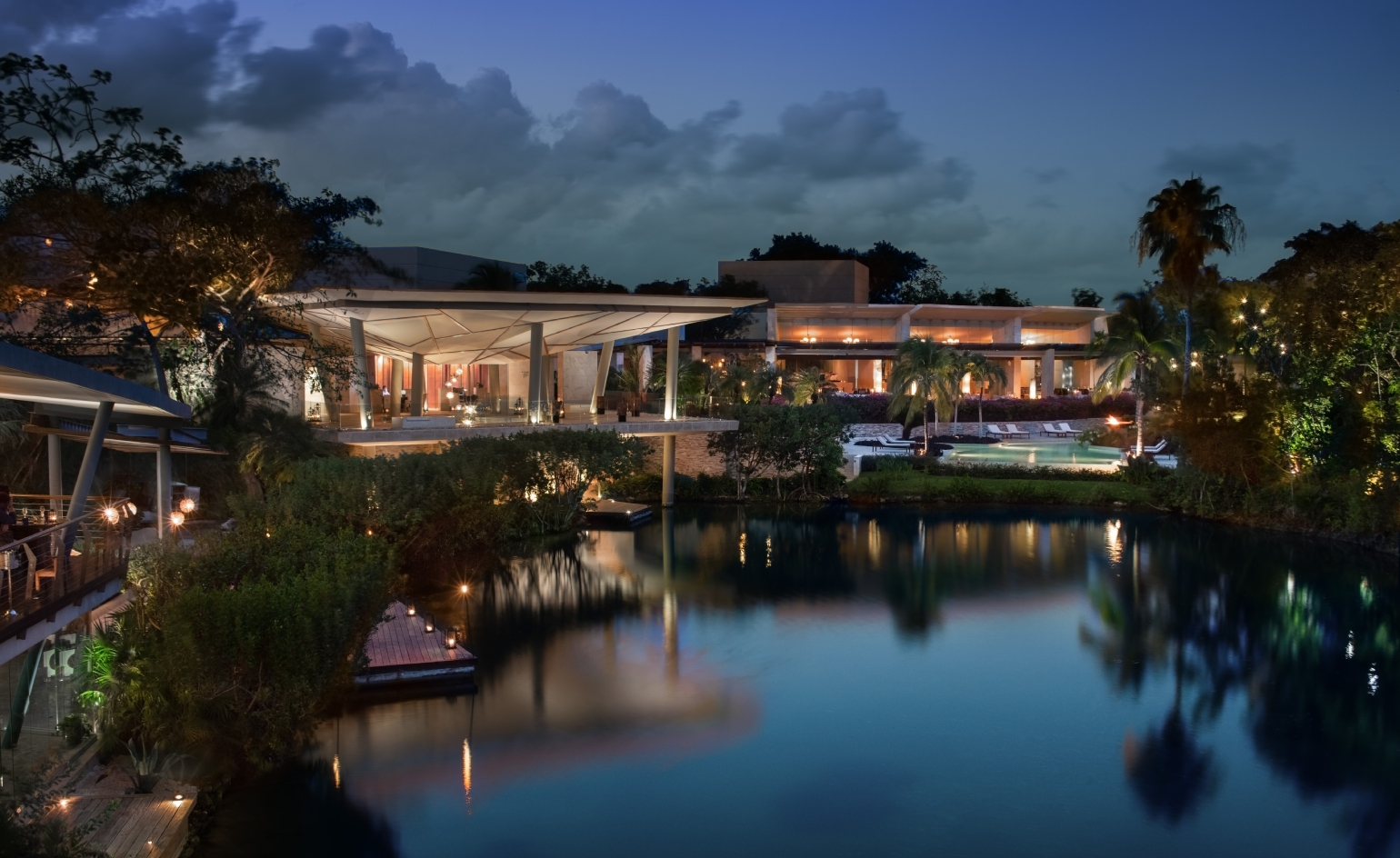 This spa in the Riviera Maya stays open until midnight. Here’s what happens after dark
This spa in the Riviera Maya stays open until midnight. Here’s what happens after darkRosewood Mayakoba’s Akbal Series proposes a new kind of night out
-
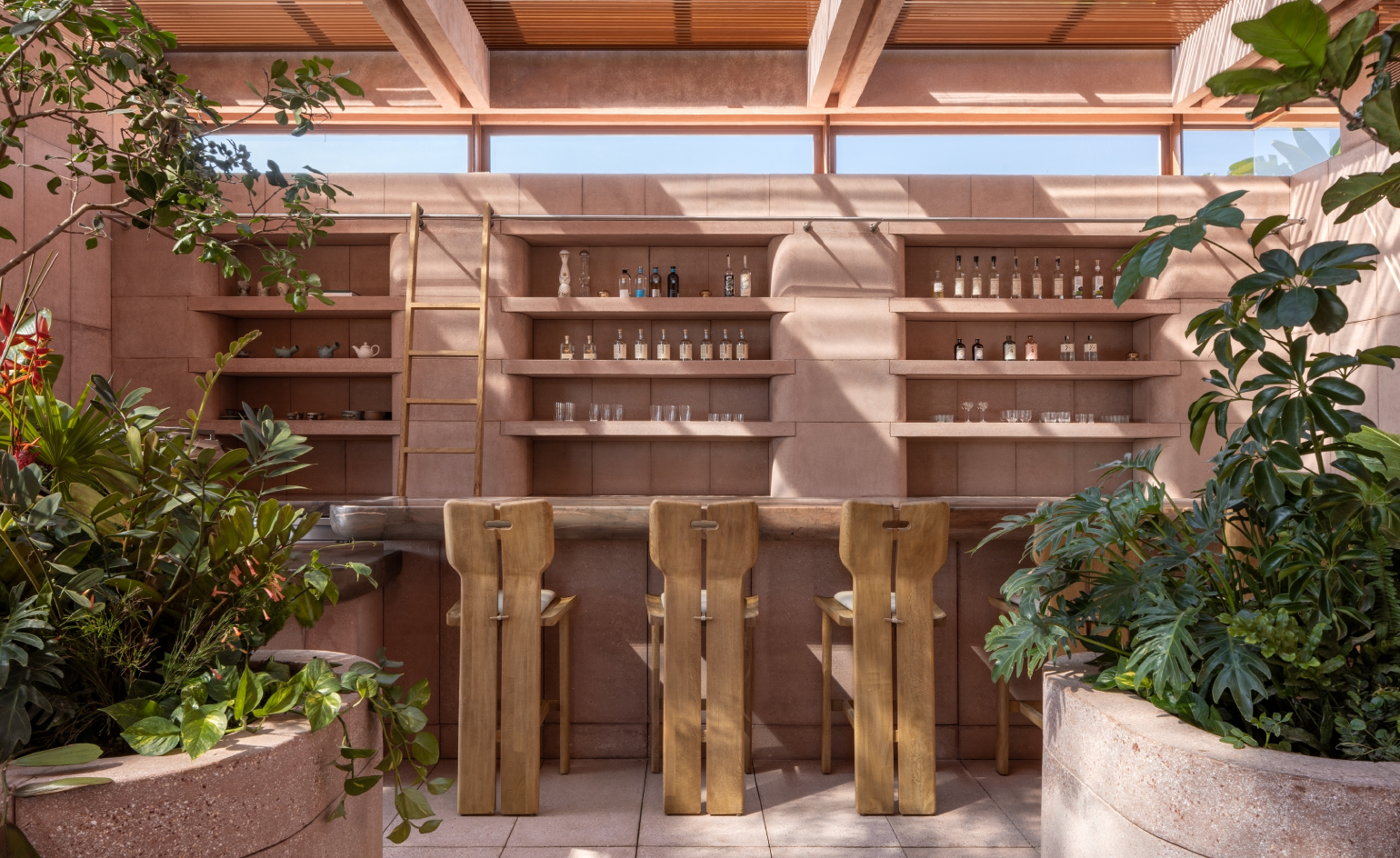 At Rubra, thrilling tropical cuisine comes courtesy of the youngest World’s Best Female Chef
At Rubra, thrilling tropical cuisine comes courtesy of the youngest World’s Best Female ChefAt chef Daniela Soto-Innes’ exceptional restaurant in Mexico’s Punta de Mita, the cooking is as ambitious as the view
-
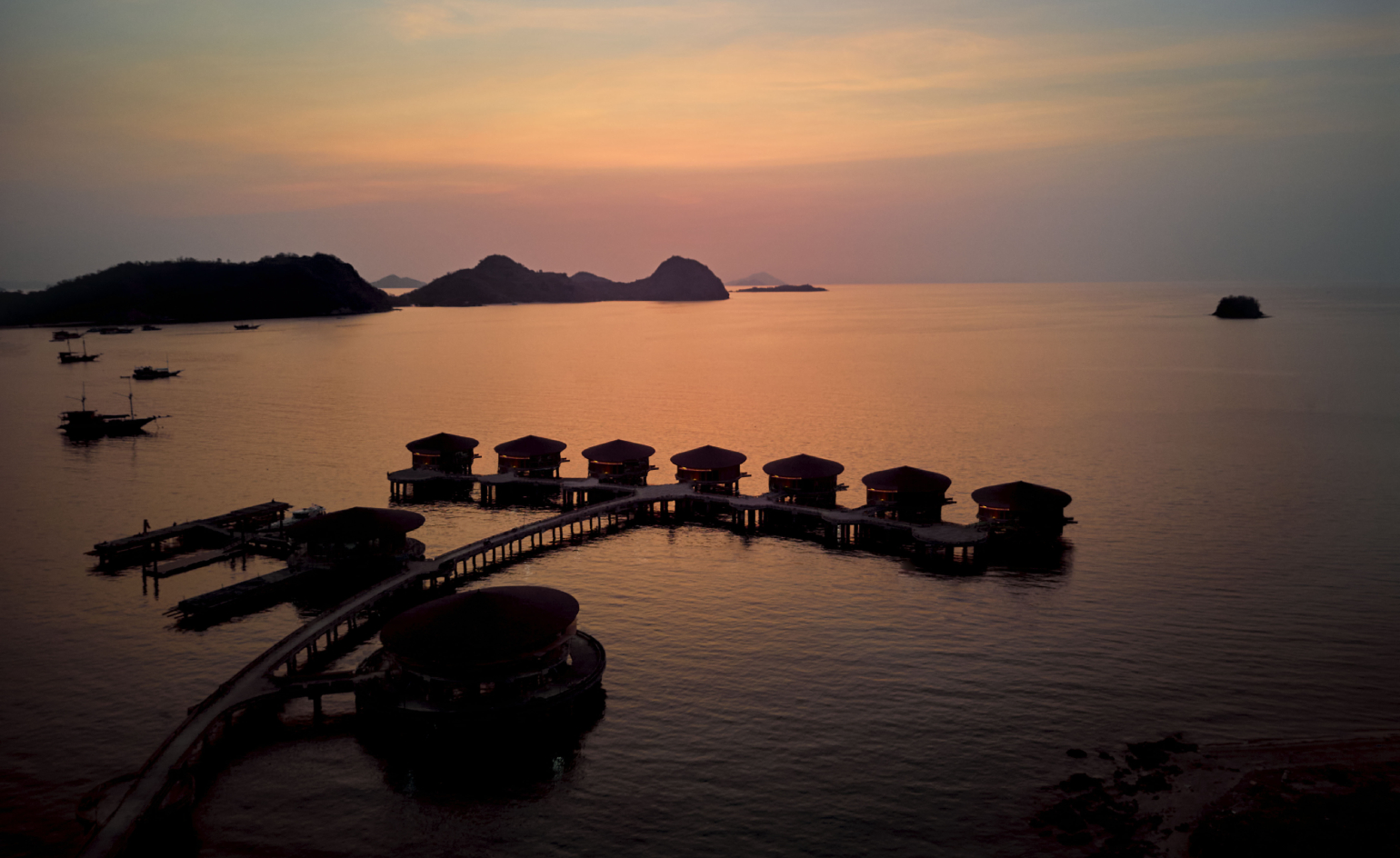 Six hotels where you’ll find the winter sun this February
Six hotels where you’ll find the winter sun this FebruaryFrom intimate seaside inns to lush tropical resorts, here are six Wallpaper*-approved winter sun escapes
-
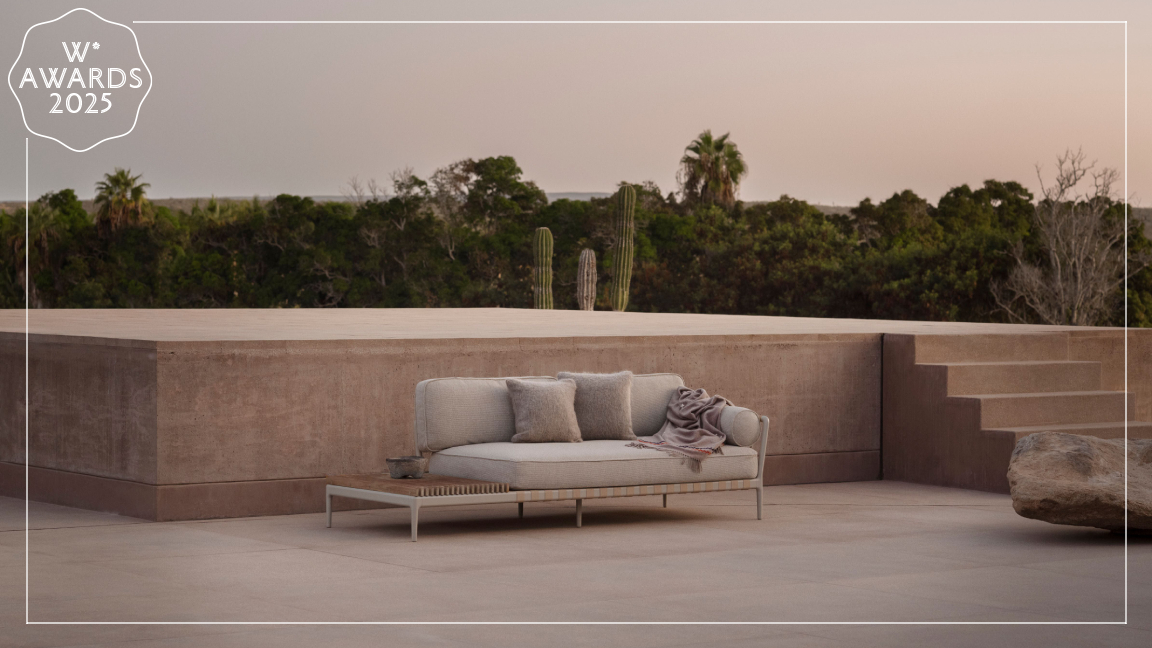 Vipp Todos Santos wins Wallpaper* Design Award 2025
Vipp Todos Santos wins Wallpaper* Design Award 2025A new guesthouse from the Danish design brand brings a Scandinavian aesthetic to a desert location in Mexico
-
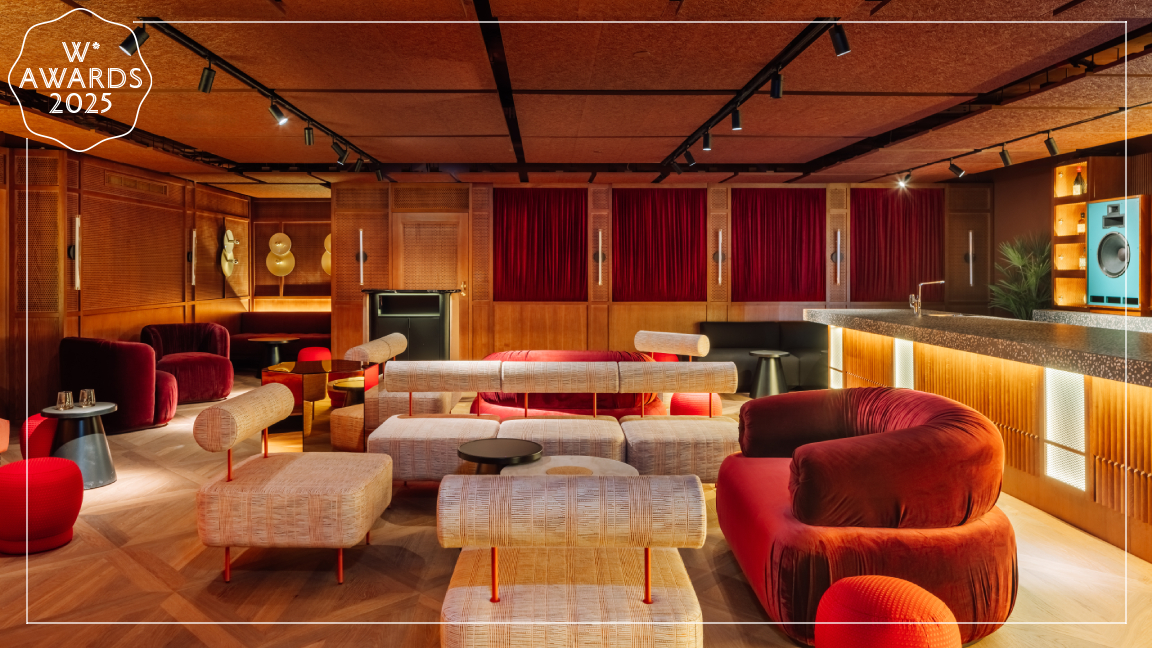 Wallpaper* Design Awards 2025: meet the travel winners transcending destinations
Wallpaper* Design Awards 2025: meet the travel winners transcending destinationsDiscover the Wallpaper* Design Awards 2025 travel winners – the year’s places to stay, dine, drink and join – and watch our video to find out why they won
-
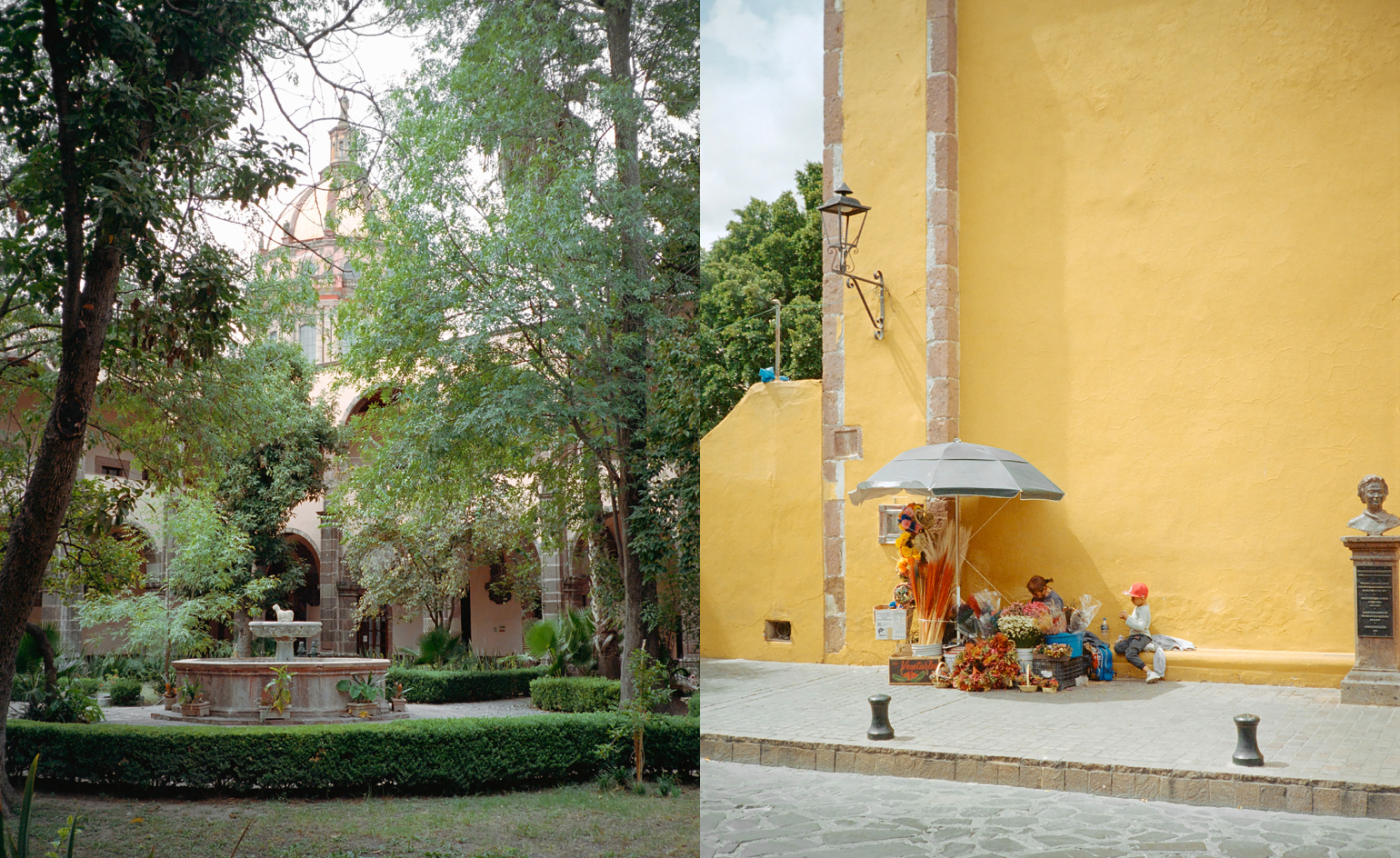 Take a trip to San Miguel de Allende, the Mexican City attracting a flourishing creative crowd
Take a trip to San Miguel de Allende, the Mexican City attracting a flourishing creative crowdSan Miguel de Allende is home to a bold young crowd of talent that’s thriving off the city’s brightly-hued heritage
-
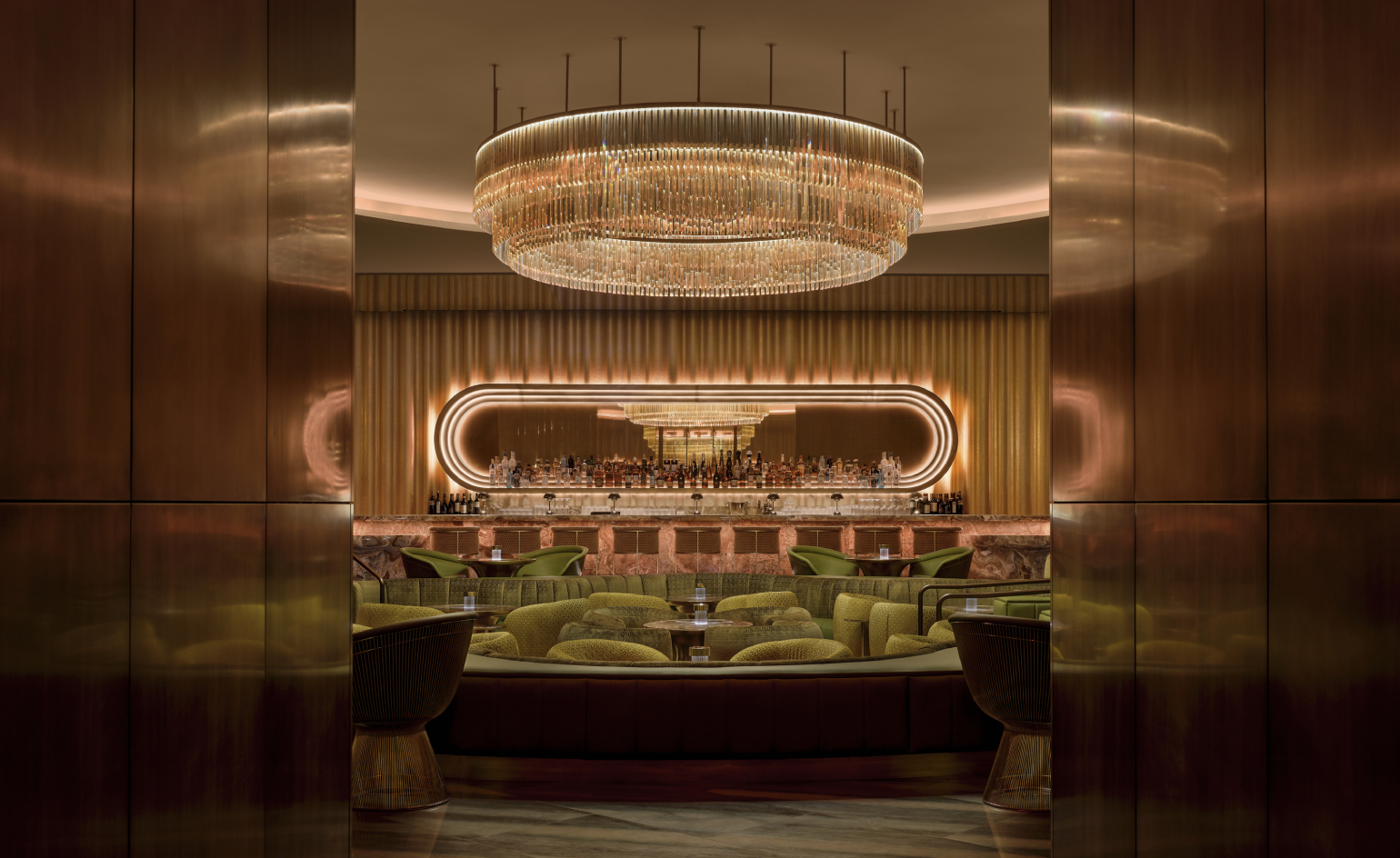 Six brilliant bars for your 2025 celebrations, hot off the Wallpaper* travel desk
Six brilliant bars for your 2025 celebrations, hot off the Wallpaper* travel deskWallpaper’s most-read bar reviews of the year can't be wrong: here’s inspiration for your festive and new year plans, from a swanky Las Vegas lounge to a minimalist London drinking den